ATLANTA AFTER PROPERTY VOL.
2
URBAN DESIGN STUDIO II
COLUMBIA GSAPP

A6820-1
INSTRUCTORS:
EMANUEL ADMASSU
NINA COOKE JOHN
CHAT TRAVIESO
JELISA BLUMBERG
REGINA TENG
A.L. HU
GALINA NOVIKOVA
FALL 2022
COLUMBIA UNIVERSITY GSAPP Fall 2022
Urban Design Studio II

PROGRAM DIRECTOR
Kate Orff
ASSISTANT DIRECTOR
David Smiley
INSTRUCTORS
Emanuel Admassu, Coordinator
Nina Cooke John
Chat Travieso
Jelisa R. Blumberg
Regina V. Teng
A.L Hu
TEACHING ASSOCIATE
Galina Novikova
TEACHING ASSISTANTS
Donnal Baijnauth
Anagha Arunkumar
Verena Krappitz
FALL 2022
STUDIO PARTICIPANTS
Aashwita Yadav
Anagha Arunkumar
Anchalinad Anuwatnontaket
Ankita Sharma
Caroline Wineburg
Chongyang Ren
Deepa Gopalakrishnan
Devanshi Gajjar
Devanshi Pandya
Di Lê
Donnal Baijnauth
Hanfei Fu
Haoyu Hu
Haoyu Zhu
Heer Shah
Hongfeng Wang
Iza Khan
Jacqueline Liu
Jade Durand
Jiani Dai
John Grunewald
Maria Gabriela Flores
Marina Guimaraes
Mingrui Jiang
Naumika Hejib
Nupur Shah
Oréoluwa Gift Adegbola
Qiannan Guo
Reya Singhi
Rohin Sikka
Rubin Lian
Rutwik Karra
Ruxuan Zheng
Saloni Shah
Sanah Mengi
Sanya Verma
Simran Gupta
Siwei Tang
Tippi Huang
Verena Krappitz
Vir Shah
Wenjun Zhu
Xiutong Yu
Xu Cheng
Yan Huo
Yaoze Yu
Yashita Khanna
Yiwan Zhao
Yue Huang
Zicong Liu
ATLANTA AFTER PROPERTY VOL.
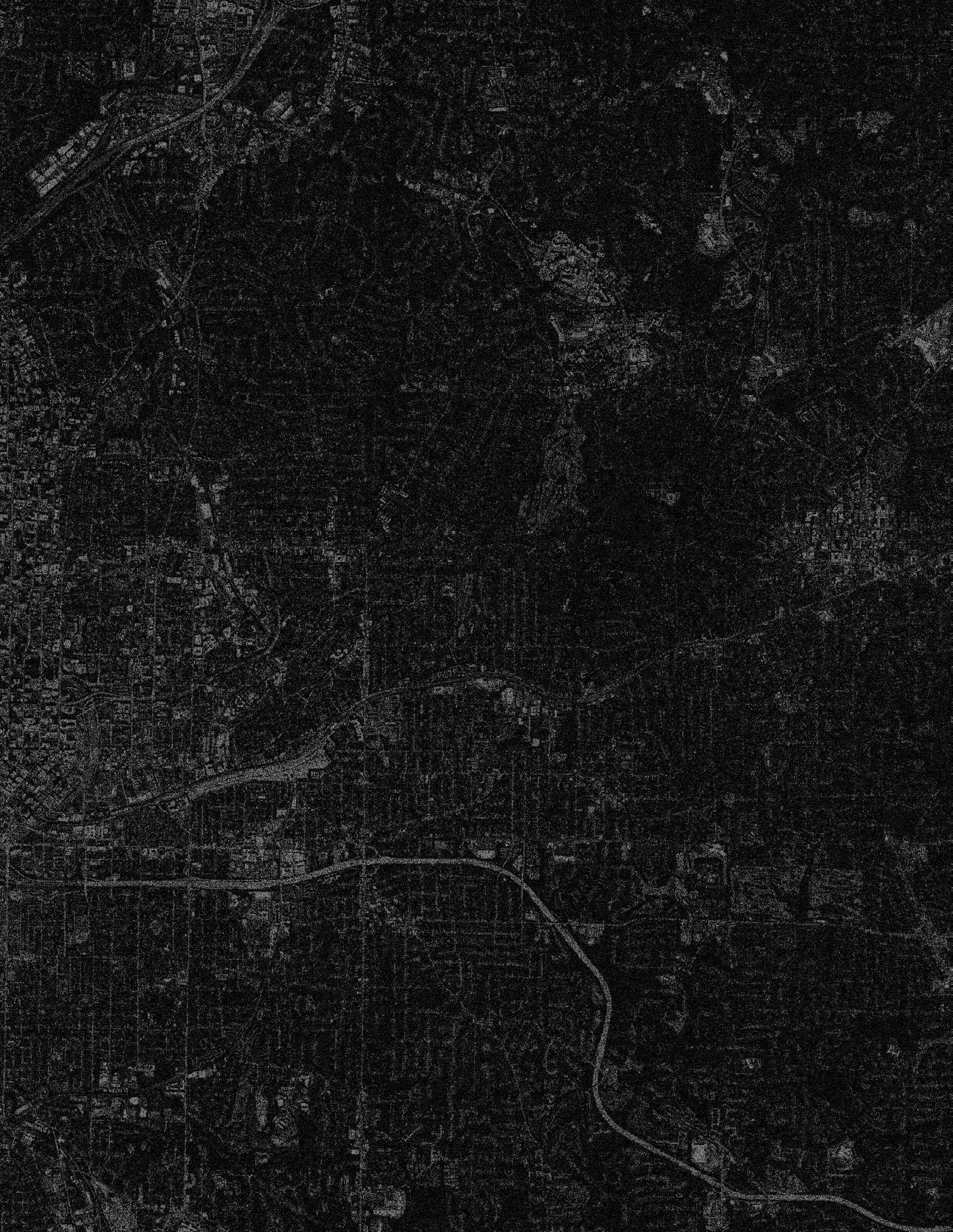
2
URBAN DESIGN STUDIO II
COLUMBIA GSAPP

A6820-1
INSTRUCTORS:
EMANUEL ADMASSU
NINA COOKE JOHN
CHAT TRAVIESO
JELISA BLUMBERG
REGINA TENG
A.L. HU
GALINA NOVIKOVA
ATLANTA AFTER PROPERTY VOL. 2
FALL 2022

07 04 03 09 02 01 13 12 05 10 06 11 08 FALL 2022 4
TABLE OF CONTENTS INTRODUCTION A Brief Introduction Studio Overview Reading List Itinerary and Site Visit PROJECTS 01 Peachtree Town Center 02 Mercedes Benz Stadium 03 Wellstar Atlanta Medical Center 04 Hulsey Yards 05 Peoplestown 06 Greenbriar Mall 07 Chattahoochee Brick Company 08 Blackhall Studios 09 Techwood Homes 10 Greenwood Cemetery 11 Forest Cove Apartments 12 Olympic Stadium 13 Downtown Parking COLLECTED SAMPLES CONCLUSION Guest Speakers Acknowledgments Epilogue I II III IV 06 - 35 36 - 141 142 - 195 196 - 201 5 ATLANTA AFTER PROPERTY VOL. 2
ATLANTA: A BRIEF INTRODUCTION
SPLIT: The Muscogee Creek people are the Indigenous stewards of the land and territory that is now known as Metro Atlanta. When Creek towns reached a population of approximately four hundred to six hundred people, they would split, with about half moving to a new, nearby site. These transient communities retained “mother-daughter” relationships between new and original towns/villages. These Indigenous spatial practices of mobility and stewardship based on mutual aid were subverted and replaced by a settler colonial logic: bifurcations fueled by covert and overt racial animus. Infrastructure built to facilitate the mobility of European settlers often doubled as a fort or embankment that limited the mobility of Black and Indigenous people. This contradiction has been maintained by the train lines that gave the city its current name and the contemporary highways that maintain these logics of negation and segregation.
Self-determination: Throughout much of the twentieth century, Atlanta was the gravitational center for the struggle for Black liberation in America. The city was at the forefront of voting rights (a tradition that continues to this day with the work of Stacey
Abrams and others), as well as Black political and economic power. It is an educational haven for Black Americans with Atlanta University Center—a consortium of four pioneering and distinguished HBCUs that include Clark Atlanta University, Spelman College, and Morehouse College.
The city has the distinction of being the one-time home of a long list of key activists and organizers including Dr. Martin Luther King Jr., Coretta Scott King, Ralph Abernathy, Ella Baker, Bayard Rustin, Andrew Young Jr., John Lewis, Rev. C.T. Vivian, Dr. Roslyn Pope, and Constance Baker Motley, as well as the headquarters of the SCLC (Southern Christian Leadership Conference) and SNCC (Student Nonviolent Coordinating Committee). The tactics employed by these activists— sit-ins, kneel-ins, and lay-ins, picket lines and boycotts, barriers destroyed and bodies blocking traffic, church meetings and university organizing, Black residential expansion and school desegregation—also have been met with bitter opposition through arrests, police brutality, white supremacist violence, restrictive deeds, exclusionary zoning, segregation walls, voter suppression, and white flight.
Disposession: The codified dispossession of land, thinly veiled through the aspirational discourse of ‘Neighborhood Improvement’ or ‘New Urbanism’ has razed all of the public housing in Atlanta. This narrative relies on
6 FALL 2022
long-standing genealogies of spatial exclusion that span from redlining to predatory lending practices; eventually leading to the complete transfer of public housing over to the private sector in2008—Atlanta built the nation's first federal housing proj-ect in 1935. The ongoing displacement and dispossession facilitated by contemporary urban remediation projects like the BeltLine, rely on similar narratives of private ownership while providing no protection for poor and low-income tenants and homeowners (median rents are up 28% since 2000—3rd in evictions, nationally).
(Mis)education: By and large, Atlanta’s public schools segregate student populations based on race. The geographic outline of the school districts continues to be redrawn in order to sustain and/or intensify segregation.
The State’s unwillingness to educate Black children is augmented by limiting the physical mobility of low-income Black families—rejecting the expansion of the MARTA and other public transportation options—and entangling the quality of schools with the speculative real estate market (property value).
Instead of maintaining a consistent quality of public education, students who are born into working class Black and brown communities in Atlanta are forced to attend schools that are designed to maintain what Eddie Glaude
Jr. calls the “value gap.”
“Contemporary urban youth are exposed to police contact more frequently and at earlier ages than their predecessors. Schools— and for those who live in public housing, even homes—have begun to resemble correctional facilities. Metal detectors, surveillance cameras, and other mechanisms designed to monitor and control inhabitants are now standard equipment in American urban schools.” — Dr.
Carla Shedd
Enclaves: Atlanta’s film industry is one of the fastest growing economic sectors in the region. Film production companies are encouraging each county to maintain specific features, landmarks, and histories. The camera-ready communities program commodifies the differences between neighborhoods as a sales pitch for film producers. In addition, a growing number of production studios are being built in and around the city, including Tyler Perry Studios, Trilith Studios, and Studio City. These mini-cities have their own socio-spatial ecosystems. At the opposite end of the spectrum, these enclaves of affluence are contradicted with concentrated enclaves of poverty: higher costs and long commutes are intensifying hardships for low-income residents that are currently being displaced from the city and trapped in the suburbs due to inadequate public transportation.
7
ATLANTA AFTER PROPERTY VOL. 2
Atlanta Committee for the Olympic Games (ACOG) Staff Member in Office With Dayto-Day Games Schedule Board | Unidentified photographer, Atlanta, 1996
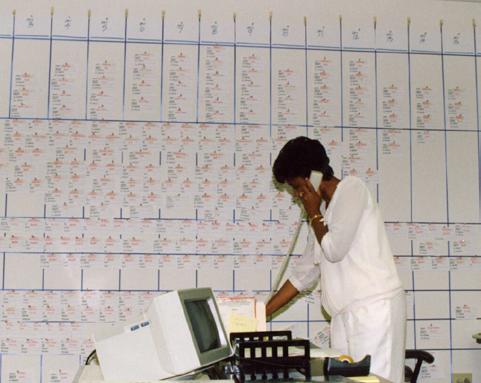
“The imaginative functions of literature and culture, [...], can reveal and intervene in the colonial, racial, and gendered structure of the property system. Further, we might look to culture for ways of articulating notions of self and community that do not buy into the universalizing logics of possessive individualism and national belonging.”
 – Grace Kyungwon Hong
– Grace Kyungwon Hong
STUDIO: A BRIEF INTRODUCTION
How can we disentangle urban design and architecture from property?1 How can we use this moment of environmental and institutional reckoning to disassemble the exploitative regimes of speculation and displacement that anchor the built environment? In other words, where do we go from here? This studio aims to identify temporal slippages and spatial practices that carve out moments of liberation from the limits of property. Studio participants will develop a collective intelligence, by gathering samples from various cultural and political geographies, to experiment with ways of seeing beyond the privatized enclosure in the metropolitan Atlanta region—the city and its sprawling suburbs.2 The aim is to design a region (with hopes of building a world) that is not tethered to individual land ownership, but instead, predicated on collective stewardship and care. This work will be done by recognizing ordinary spatial practices that operate against the hegemony of real estate. Through radical reinterpretations of historical and contemporary interventions where the everyday struggle begins to approach the surreal, we aim to liberate urban design from its historical commitment to borderization.3 We will celebrate undervalued spatial practices that actively dismantle the Cartesian frame of racial capitalism, as a gathering of performances committed to imaging a different world, because the status-quo is untenable. Atlanta After Property reframes the discipline of urban design by re imagining the city of Atlanta in solidarity with contemporary movements of Black liberation and mutuality; working against the ruthless policing, dispossession, and displacement of marginalized communities.
HHR, W.E.B. DU BOIS in his Atlanta University office, 1909
SITE (noun)A place, scene, or point of an occurrence or event.
8 FALL 2022
READING 01
READ: ARGUMENTS & DIAGRAMS
Team: Groups of four or three
Assigned: September 8th, 2022
Review: September 12th, 2022
The first assignment, Episode 01, will be accompanied by a series of readings. Each studio participant will read at least three texts from the list provided in the syllabus. Then, students will form groups of four to analyze and generate a short visual presentation on one of the readings. These readings—framing critical questions—will serve as foundations for our discourse on property, means of representation, and the urban conditions of Metro Atlanta.
How can we imagine a world after property?
Participants will examine ‘as found’ sites and spatial practices by everyday people that work against the alienating nature of private property.4 These samples will be added to the collective catalog of the studio. By drawing examples of communality that prioritize care over surveillance, we will imagine a world after property.
Is property a metonym for theft?
This studio will identify and define precise sites of privatization by selecting and transforming ‘as
found’ urban conditions that are emblematic of the contemporary regime of property. Participants will investigate the cultural, political, and spatial structures that continue to transform communal environments into securitized zones.
EPISODE 01
RESEARCH: SAMPLES & SITES
Team: Groups of two (or three) Assigned: September 8th, 2022 Review: September 22nd, 2022
Participants will work in pairs to select critical images and invent analytical drawing techniques that identify, take account, and diagram specific ‘Samples’ and ‘Sites’. For the purposes of this studio, Samples are defined as existing spatial concepts and practices that defy the bounds of property. Inversely, Sites are defined as existing spatial conditions in metro Atlanta that are representative examples of the schema that defines the contemporary regime of property.
How can we use images to open new readings of history?

This studio aims to develop historical depth by navigating and mining images that have been used to document Atlanta’s transformations over time. This image research will offer another way of knowing the place before our visit to Atlanta.
“However, when Atlanta was named host of the 1996 Olympics in 1990, public housing demolition for temporary athlete housing (that would become permanent mixed-income communities) seemed like and ideal (public-private) solution for a public burden. Over two decades, approximately 7,000 public housing units were demolished, with less than 40% of all displacees eligible and willing to return to new public-private developments. Since 2007, the city has grappled with a foreclosure crisis that stands to remove even more working-class political interests from the city.”
— Akira Drake Rodriguez
The imperative to quantify and measure value created an ideological juggernaut that defined people and land as unproductive in relation to agricultural production, and deemed them to be waste and in need of improvement. The creation of an epistemological framework where people came to be valued as economic units set the ground for a fusing of ownership and subjectivity in a way that had devastating consequences for entire populations who did not cultivate their lands for the purpose of commercial trade and marketized exchange. These populations were by definition uncivilized and could be disposed of, cast out of the borders of political citizenship.”
— Brenna Bhandar
Kara Walker Exodus of Confederates from Atlanta from Harper's Pictorial History of the Civil War (Annotated). 2005
9 ATLANTA AFTER PROPERTY VOL. 2
“A practice is an unfinished or ongoing process. It designates a durational temporality that functions as a process of preparation. Practice is also fundamentally social in nature, as it forms a core role in the formation of subjectivity. More specifically, in this case, it is the social process of preparation required to enact new ways of inhabiting freedom.”
—Tina M. Campt
“The premise of the CLT relies on distinguishing the interest in the land itself from the interest in using the land. The land interest is held by a non-profit organization which holds the land ‘in trust’ for a particular community and its future residents, while the plot’s use interest is held by a leaseholder, who agrees to a long-term rental and resale agreement.”
— Gabriel Cuéllar and Athar Mufreh
How can we reclaim proximity?5
Participants will carefully examine how the logics of property produce spaces that overdetermine our physical interactions. The algorithmic abstraction of global capital and land speculation are continuing to produce homogenous cities; making them increasingly inaccessible zones for working class people. Therefore, unbuilding the cultural, political, and economic forces that delimit cities requires a critical engagement with the images used to do this work.
How can we resist removal?
Various, well-intentioned urban remediation projects like BeltLine Atlanta exponentially increase surrounding property value, contributing to the massive displacement of low-income communities. Understanding that the harm done to the environment is inextricably linked to the harm done to people, we will analyze how private developers continue to receive incentives and subsidies from tax dollars, leading to the ongoing abandonment of the civic realm, defunding public schools and public transportation.
EPISODE 02
TRANSLATE: SELECT & CATALOG Team: Groups of four (or three)
Assigned: Sept. 22nd, 2022
Review: Oct. 3rd, 2022
Two groups from Episode 01 will merge to form groups for Episode 02; inheriting four Samples and Sites from another group. The inherited Samples and Sites will be carefully sharpened—both conceptually and representationally. This will require further research and iteration on the arguments, images, and diagrams used to depict the samples and sites from Episode 01.
Consequently, each group will select and contribute two samples and one site to two catalogs: Collective Sample Catalog and Collective Site Catalog (the socio-spatial boundaries of each site will be defined by the group) in the metropolitan Atlanta region.

Is liberation achieved during, before or after property?
Each group will test various combinations through models and images—organizational, representational, and material—of the fragments in the collective catalog.6 The strategies gathered from these concepts will inform the dismantling of property.
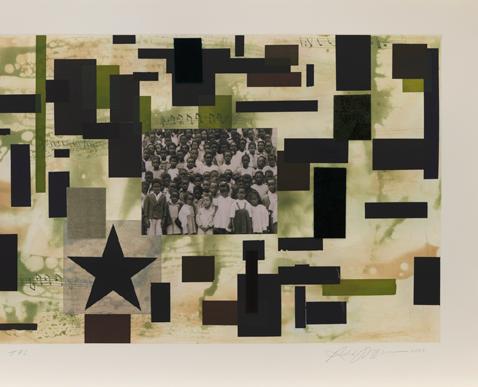
Is property another word for prison?
The aim is to generate arguments and images that work against the ongoing borderization of the planet. We will establish
FX’s ATLANTA, Season 1
Radcliffe Bailey. In The Garden. 2003
10 FALL 2022
frameworks for mutual aid and communality that refuse the transformation of cities into homogenous zones of speculation.7
EPISODE 03
DESIGN:
ARGUMENTS & MODELS
Team: Groups of four (or three)
Assigned: Oct. 3rd, 2022
Review: Oct. 27th, 2022
Each group will select samples from the collective catalog. These samples will be used to redesign one of the sites in the collective catalog, prefiguring a world after property. The samples will be selected based on their potential to redress recursive dispossessions. What are the alternatives to the tyranny of permanence?
This studio will reintroduce people that were displaced from the city and liberate spaces that have been imprisoned by property.8
Is property foreclosing the promise of a livable planet?
Participants will sample from the collective catalog to establish frameworks for the production of alternative futures: free from alienation and dispossession.9
Mining key episodes from the historical evolution of the samples, we aim to fortify our commitment to the cultivation of a livable planet.10
EPISODE 04
RECONSTRUCT: ITERATE & STUDY
Team: Groups of four (or three)
Assigned: Nov. 7th, 2022
Review: Nov. 21st, 2022
The site will be reconstructed to reflect the various forms of cohabitation (human and morethan-human) that have been erased.11 This will be an iterative process, transforming the samples and sites of each project. The aim is to search for alternatives to speculative, predatory forms of land ownership, that undergird the built environment.12 It is an opportunity to imagine new ways of relating to our planet and to one another.13
EPISODE 05
PRESENT: DRAW & MODEL
Team: Groups of four (or three)
Assigned: Nov.19th, 2022
Review: Dec. 5th, 2022
The final presentation will be a non-linear accounting of the research and design decisions that generated your vision of Atlanta after property.14 The coherence and contradiction between your samples and sites will reveal transformative opportunities to redefine the limits of urban design.15
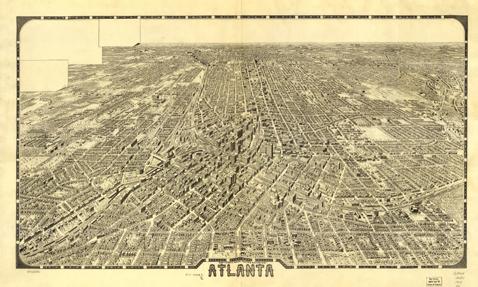
“Worldbuilding is utilized as a powerful feminist tool in Himid’s practice. The gallery space is transformed into a site where many of us audience members, curators, and artists alike—can congregate, converse and even time travel together as we move from one reality to the next by encountering each canvas.”
— Amrita Dhallu
“In this breathtaking moment, those who have been heir to most of the harm have been offering the most incisive critiques and the most potent antidotes, and they are often speaking a spatial language that inhabits the urban stage. Communities that rely on presence, proximity, and entanglement have special powers to provide some relief from or reparation for the environmental violence of dispossession, gentrification, policing, and climate catastrophes.”
— Keller Easterling
“While the legal transformation from slavery to freedom is most often narrated as the shift from status to contract, from property to subject, from slave to Negro, vagrancy statues make apparent the continuities and entanglements between a diverse range of unfree states—from slave to servant, from servant to vagrant, from domestic to prisoner, from idler to convict and felon.”
— Saidiya Hartman
Foote and Davies Company, Atlanta, 1919
11 ATLANTA AFTER PROPERTY VOL. 2
W. E. B. Du Bois, “Chapter 5: Of the Wings of Atalanta,” The Souls of Black Folk;EssaysandSketches (Chicago: A. C. McClurg and Co., 1903).
Karen Pooley. “Segregations New Geography: The Atlanta Metro Region, Race, and the Declining Prospects of Upward Mobility,” in SouthernSpaces, April 15, 2015.
Ronald H. Bayor. “Chapter 3 - City Building and Racial Patterns,” in Race andtheShapingofTwentiethCentury Atlanta.Chapel Hill, North Carolina: The University of North Carolina Press, 1996.
Dan Immergluck. RedHotCity:Housing,Race,andExclusioninTwenty-First-CenturyAtlanta. Berkeley: University of California Press, 2022.
Kevin M. Kruse. “Epilogue: The Legacies of White Flight,” in WhiteFlight:AtlantaandtheMakingofModernConservatism. Princeton; Oxford: Princeton University Press, 2005, p. 259-266.
Krista A. Thompson. “Performing Visibility: Freaknic and the Spatial Politics of Sexuality, Race, and Class in Atlanta,” in TDR: The Drama Review 51:4 (T194) Winter 2007.

Akira Drake Rodriguez. “Introduction” and “Public Housing Developments as Political Opportunity Structures,” in DivergingSpaceofDeviants:ThePolitics ofAtlanta’sPublichHousing. Athens, GA: University of Georgia Press, 2021, p. 1-18 and 209-219.
NOTES
1. Grace Kyungwon Hong. “Property,” in KeywordsforAmerican Cultural Studies, edited by Bruce Burgett and Glenn Hendler. NYU Press, 2007, p. 180–83.
2. Akira Drake Rodriguez. ““What is Our City Doing for Us?”: Placing Collective Care into Atlanta’s Post-Public Housing Movements.” Antipode. Vol. 0 No. 0 2022.
3. Brenna Bhandar. “Lost property: The continuing violence of improvement.” Architectural Review. October 8 2020. https:// www.architectural-review.com/ essays/lost-property-the-continuing-violence-of-improvement.
4. Tina M. Campt. “Constellations of Freedom: Assembly, Reflection, and Repose,” in In Search of African American Space:RedressingRacism, edited by Jeffrey Hogrefe, Scott Ruff, Carrie Eastman, Ashley Simone. Lars Muller Publishers, September 29 2020, p. 12-17.
5. Gabriel Cuéllar, Athrah Mufreh. “Virtues of Proximity: The Coordinated Spatial Action of Community Land Trusts.” Footprint. May 31 2022. Vol. 15 No. 2, 2021, p.23-44, https://doi. org/10.7480/footprint.15.2.
6. Amrita Dhallu. “To Build Otherwise,” in Lubaina Himid, edited
by Michael Wellen. London: Tate Publishing, 2021, p. 40–61.
7. Keller Easterling. “Other Than “The City”.” Public Culture [forthcoming].
8. Saidiya Hartman. “The Anarchy of Colored Girls,” in WaywardLives,BeautifulExperiments:IntimateHistories ofSocialUpheavals. New York: WW. Norton & Company, 2019, p. 465-490.
9. Carla Shedd. “The Universal Carceral Apparatus,” in Unequal city:Race,schools,andperceptionsofinjustice. Russell Sage Foundation, 2015, p. 80–119.
10. Zadie Smith. “Toyin Ojih Odutola’s Visions of Power.” The New Yorker. August 10 2020. https://www.newyorker. com/magazine/2020/08/17/ toyin-ojih-odutolas-visions-of-power
11. Vanessa Watts. “Indigenous Place-Thought and Agency Amongst Humans and Non-humans (First Woman and Sky Woman Go on a European World Tour!).” Decolonization:Indigeneity,Education&Society. May 4 2013. Vol 2. No. 1, p. 20–34.
12. Mabel O. Wilson. “Mine Not Yours.” Dimensions of Citizenship, e-flux Architecture, July 4 2018. https://www.e-flux.com/ architecture/di-men
Latto, Photograph by Eric Hart Jr. for Rolling stone, 2022.
12 FALL 2022
sions-of-citizenship/178292/ mine-not-yours/
13. Sylvia Wynter. “1492: A New World View,” in Race,discourse, andtheoriginoftheAmericas:A new world view, edited by Hyatt, Vera Lawrence, Nettleford, Rex M. Washington: Smithsonian Institution, 1995.
14. K. Wayne Yang. “Sustainability as Plantation Logic, or, Who Plots an Architecture of Freedom?” Settler Colonial Present, e-flux architecture. October 16 2020. https://www.e-flux. com/architecture/the-settler-colonial-present/353587/ sustainability-as-plantationlog-ic-or-who-plots-an-architecture-of-freedom/
15. Rinaldo Walcott. “Abolition Now: From Prisons to Property,” in OnProperty:Policing,Prisons, and the Call for Abolition. Windsor, Ontario : Biblioasis, 2021.
“A recent investigative report released in February 2018 documented how discriminatory practices in bank lending have not disappeared, despite the fact that the Fair Housing Act of 1968 made many of them illegal. These patterns of discrimination have reemerged in loan allocations that have financed the gentrification of urban neighborhoods around the country.”
— Mabel O. Wilson12
“For it was to be in the context of this generalized challenge that Frantz Fanon would propose, against our present bicentric natural-instinctual and thereby arbitrary model of human behaviors, a new contestatory image of the human.”
— Sylvia Wynter13
“Wynter and McKittrick also imply other definitions of the world plot. A plan. A conspiracy. A drawing. An architecture.”
— K. Wayne Yang14
Two dope boys on a Cadillac: ANDRE 3000 AND BIG BOI in the early days. Michael Ochs Archives/Getty Images.

“Ruth Wilson Gilmore has argued that abolition is not about, as so many have claimed, taking away anything; rather, it is concerned with the presence of being—of fully being: the self needs to be present to others beyond itself.”
— Rinaldo Walcott15
13 ATLANTA AFTER PROPERTY VOL. 2
FALL 2022
EPISODE 01 EPISODE 02 EPISODE
RESEARCH: SAMPLES & SITES
TRANSLATE: SELECT & CATALOG
DESIGN: ARGUMENTS
READING 01
1 — Read, analyze, and present a reading
EPISODE 02
7 — Select, edit, and contribute samples to the Collective Site Catalog
EPISODE 01
2 — Identify and diagram samples & site in groups of two (one group of three)
EPISODE 02
6 — Select, edit, and contribute samples to the Collective Sample Catalog
EPISODE 8 — Using a lottery choose from the
EPISODE 9 — Redesign using samples
EPISODE 02
5 — Inherit samples and sites from another group
EPISODE 02
4 — Transfer your combined samples and sites to another group
EPISODE 02
3 — Using a lottery system, merge with another group to form groups of four (one group of three)
Sample Sample Site 6
14
s
FALL 2022
ATLANTA AFTER PROPERTY VOL. 2
ATLANTA AFTER PROPERTY VOL. 2
EPISODE 03 EPISODE 04 EPISODE 05
DESIGN: ARGUMENTS & MODELS
RECONSTRUCT: ITERATE & STUDY
PRESENT: DRAW & MODEL
EPISODE 03
lottery system, choose a site the catalog
EPISODE 03
Redesign this sites samples
READING 02 10 — Read, analyze, and present a reading
EPISODE 04 11 — Iterate and reconstruct the site
EPISODE 05
12 — Present your vision of Atlanta after property
7
15
FRAMING CRITICAL QUESTIONS ON READING LIST:
PROPERTY
Amrita Dhallu, “To Build Otherwise,” in Lubaina Himid, edited by Michael Wellen. London: Tate Publishing, 2021, p. 40–61.
Brenna Bhandar, “Lost property: The continuing violence of improvement.” Architectural Review. October 8 2020.
Carla Shedd, “The Universal Carceral Apparatus,” in Unequal city: Race, schools, and perceptions of injustice. Russell Sage Foundation, 2015, p. 80–119.
Gabriel Cuéllar, Athrah Mufreh, “Virtues of Proximity: The Coordinated Spatial Action of Community Land Trusts.” Footprint. May 31 2022. Vol. 15 No. 2, 2021, p.23-44.
Grace Kyungwon Hong, “Property,” in Keywords for American Cultural Studies, edited by Bruce Burgett and Glenn Hendler. NYU Press, 2007, p. 180–83.
K. Wayne Yang, “Sustainability as Plantation Logic, or, Who Plots an Architecture of Freedom?” Settler Colonial Present, e-flux architecture. October 16 2020.

Keller Easterling, “Other Than “The City”.” Public Culture [forthcoming]
Mabel O. Wilson, “Mine Not Yours.” Dimensions of Citizenship, e-flux Architecture, July 4 2018.
Rinaldo Walcott, “Abolition Now: From Prisons to Property,” in On Property
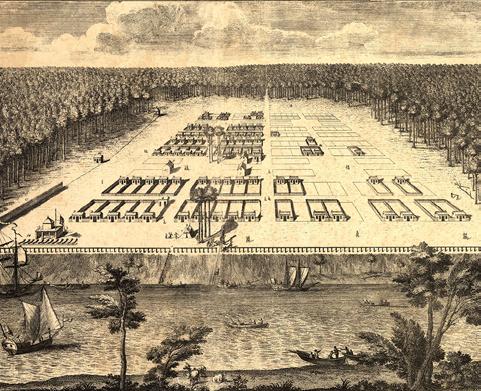
Saidiya Hartman, “The Anarchy of Colored Girls,” in Wayward Lives, Beautiful Experiments: Intimate Histories of Social Upheavals. New York: WW. Norton & Company, 2019, p. 465-490.
Sylvia Wynter, “1492: A New World View,” in Race, discourse, and the origin of the Americas: A new world view, edited by Hyatt, Vera Lawrence, Nettleford, Rex M. Washington: Smithsonian Institution, 1995.
Tina M. Campt, “Constellations of Freedom: Assembly, Reflection, and Repose,” in In Search of African American Space: Redressing Racism, edited by Jeffrey Hogrefe, Scott Ruff, Carrie Eastman, Ashley Simone. Lars Muller Publishers, September 29 2020, p. 12-17.
Vanessa Watts, “Indigenous Place-Thought and Agency Amongst Humans and Non-humans (First Woman and Sky Woman Go on a European World Tour!).” Decolonization: Indigeneity, Education & Society. May 4 2013. Vol 2. No. 1, p. 20–34.
Zadie Smith, “Toyin Ojih Odutola’s Visions of Power,” The New Yorker, August 10, 2020.
 Mabel O. Wilson, “Mine Not Yours.”
Harwell Hamilton Harris, Weston Havens House, Berkeley, 1940. Photo: Maynard L. Parker. The Huntington Library, San Marino, California.
Zadie Smith, “Toyin Ojih Odutola’s Visions of Power”
Mabel O. Wilson, “Mine Not Yours.”
Harwell Hamilton Harris, Weston Havens House, Berkeley, 1940. Photo: Maynard L. Parker. The Huntington Library, San Marino, California.
Zadie Smith, “Toyin Ojih Odutola’s Visions of Power”
16 FALL 2022
Brenna Bhandar, “Lost Property,” 2020.
AFTER-PROPERTY FRAMING CRITICAL QUESTIONS ON

Arata Isozaki, “Erasing Architecture into the System,” in Re: CP, edited by Hans Ulrich Obrist (Basel, Switzerland: Birkhauser – Publishers for Architecture, 2003), pp. 25-47.
Browne, Simone, “Dark matters: On the surveillance of blackness.”
Catherine R. Squires, “Rethinking the Black Public Sphere: An Alternative Vocabulary for Multiple Public Spheres, Communication Theory,” Volume 12, Issue 4, 1 November 2002, Pages 446–468
Christina Diaz Moreno and Efren Garcia Grinda, “Everyday Delights,” (A conversation with Anne Lacaton & Jean Philippe Vassal) Nd “Lacaton & Vassal [Post-Media Horizon].” In El Croquis 177+178 (2015), 5 – 31.
Elleza Kelley, “No Man’s Land: The Architecture of Abolition,” in Imagination and theCarceral State, edited by Joshua Benne, Cabinet (8 December 2020)
Elleza Kelley, “Follow the Tree Flowers’”: Fugitive Mapping in Beloved,” in Antipode: A Radical Journal of Geography (2020)

Erica Avrami, “Toward Equitable Communities: Historic Preservation in Community Development: An Interview with Maria Rosario Jackson.” Preservation and Social Inclusion, Columbia Books on Architecture and the City, New York, NY, 2020, pp. 245–249.
Fred Moten and Stefano Harney, “Planning and Policy,” in The Undercommons: Fugitive Planning and Black Study, (New York: Minor Compositions, 2013) pp. 70 –84.
Guy Debord, “The Decline and Fall of the Spectacle Commodity (1965),” Situationist International Archive, https://www.cddc.vt.edu/sionline/si/decline.html
Harry Garuba, “Explorations in Animist Materialism: Notes on Reading/Writing African Literature, Culture, and Society,” in Public Culture Volume 15.2 (Duke University Press, 2003), 261 – 285.
June Meyer, “Instant Slum Clearance,” in Esquire. Vol. 63, no. 4, whole no. 377 (Apr.1965), pp. 108-111.
Mariame Kaba, “We Do This ‘Til We Free Us,” Haymarket Books, 2021.
Rinaldo Walcott, “The Black Aquatic,” liquid blackness, 2021, pp. 63–73.
Spade, Dean, “Mutual Aid: Building Solidarity during This Crisis (and the next).”
Sylvia Wynter, “Novel and History, Plot and Plantation,” in Savacou 5, (1972), pp. 95 – 101.
The Care Collective, “Caring Communities.” The Care Manifesto: The Politics of Interdependence
Beverly Buchanan, Marsh Ruins, Marshes of Glynn
Overlook Park, Brunswick, Georgia, 1981. Elleza Kelly, “No Man’s Land
June Meyer, “Instant Slum Clearance” Skyrise Harlem.
17 ATLANTA AFTER PROPERTY VOL. 2
ATLANTA
TRIP ITINERARY | OVERVIEW
DAY 01
Midtown Lunch & Walk
Civil Bikes Walking Tour
Beltline Walk to Ponce Street
Market
Studio Dinner
DAY 02
Artist Talk + Studio Visit
High Museum
LOCATIONS & MEETING AND POINTS
DAY 03
Panel Discussion Site Visit with The Guild Team Site Visits
DAY 04
Studio Breakfast + Debrief
GSAPP Departs
ATLANTA HILTON HOTEL
Atlanta Hilton Hotel, 255 Courtland St NE, Atlanta, GA 30303
HIGH MUSEUM
High Museum of Art, 1280 Peachtree St NE, Atlanta, GA 30309
CIVIL BIKES WALKING TOUR
King National Park - Amphitheater 450 Auburn Avenue NE, Atlanta, GA 30312
ARTIST STUDIO : YANIQUE NORMAN
Westview Studios, Suite 302, 1450 Ralph David Abernathy Blvd Atlanta, GA 30310
PANEL DISCUSSION
Haugabrooks, 364 Auburn Ave NE, Atlanta, GA 30312
THE GUILD - SITES
1st Project - 918 Dill Ave Sw, Atlanta, Ga
2nd Project - 1187 Ira Street Sw, Atlanta, Ga
18
FALL 2022
ARTIST STUDIO
 HIGH MUSEUM
CIVIL BIKES
PONCE ST. MARKET
DOWNTOWN
PANEL DISCUSSION
KROG ST TUNNEL
SW ATLANTA
HILTON HOTEL
HIGH MUSEUM
CIVIL BIKES
PONCE ST. MARKET
DOWNTOWN
PANEL DISCUSSION
KROG ST TUNNEL
SW ATLANTA
HILTON HOTEL
ATLANTA:
Day 01 |Thursday, Oct. 20th, 2022
Midtown Lunch & Walk
Civil Bikes Walking Tour
Directions: Meet at King National Park - Amphitheater 450 Auburn Avenue NE, Atlanta, GA 30312 .
Ponce Street Market: Studio Dinner
John Wesley Dobbs Plaza, Fort St NE and Auburn Ave NE, Atlanta, GA 30312
Through his work as an architect and urban designer, Desmond questions what it truly means for a city such as Atlanta to ‘develop’. “A lot of the preservation and rebuilding efforts in Atlanta are driven by enterpreneurs in the Black community, and the Black Church.”
Nedra Deadwyler Founder, Civil Bikes Historian & Social Worker
“After being in gentrified cities from New York to Seattle, I realized that if we don’t talk about history and place, the very existence and inter-relatability of personal space and the public sphere, we are letting the same thing happen here in Atlanta.



So now we do everything from bike tours to advocacy centered mobility justice, among other issues.
One of the milestones we achieved was the conference ‘Untokening’ in 2012, a space for BIPOC and queer people, people experiencing disability and women to talk about being untokenized. A lot of planning erases us - we’re not even a part of the conversation.”

Rev Bryant, Antoine Graves 522 Auburn Ave NE, Atlanta,
“I don’t want to see Atlanta cessible city that won’t make new residents.”
Colin Delargy Graduate Student: Master Planning + Public Policy,
“Housing is definitely on the focus is on housing production, City, has over the last thirty cally cut its ability to do there are a lot of relationships built, fostered or continued financial actors, and more private sector.”
Desmond Johnson
Architect + Urban Designer
Brittany Williams Community Organizer
20 FALL 2022
Graves House, HDDC, Atlanta, GA 30312
Atlanta become an inacmake room for old and

Leslie Spencer
Atlanta-based Historian
Leslie’s work in uncovering and documenting the history of Atlanta is essential to understand how Black life has unfolded in the city - from birth to death, everyday domesticity, and the creation of Black wealth in times of deep racial divide and discrimination.
Master of City and Regional Policy, Georgia Tech
on the City’s agendaproduction, but the thirty years, systemithis. This means that relationships that need to be continued with developers, more stakeholders in the


21 ATLANTA AFTER PROPERTY VOL. 2
Thursday October 20, 2022
The Atlanta studio’s sojourn begins at the Martin Luther King Memorial. We begin to imagine what is thought to be the unimaginable, just as King did in this very spot.
A walking tour with Nedra of Civil Bikes traces the seam of the Old Fourth Ward and leads into the Beltline. Her stories of Black activism in segregated Atlanta offers a glimpse into the people that shaped this city.

Juxtaposed with its present and future, we walked pass Atlanta’s historical schools, homes, and remnants of its industrial past.
The Beltline is lined with the same combination of old and new buildings. Some are repurposed, some are abandoned to the vagaries of time.
Newly constructed buildings look similar, with stacks of apartments and glass balconies wrapping around their exteriors, in stark contrast to the artfully weathered industrial aesthetic of the refurbished structures.
The Beltline offers no spaces of respite beyond the pressure of commerce or the exclusivity of luxury housing. As a result, everyone strides purposefully, constantly on the move.

The Beltline displays its fair share of murals and graffiti. Curated art along the metal walls hide new construction, and tagging under the elevated transit corridors.
We met Colin in the shadow of
a high-rise under construction. His perspective on how the city is dealing with the housing crisis is almost drowned out by the din of the construction.
Colin’s words shed light on the necessity for strong partnerships between the city, private stakeholders in real estate, finance, insurance, as well as community organizations for Atlanta’s vision for inclusive housing.
Pondering our conversations with Nedra and Colin, we made our way back to the memorial for another set of enlightening discussions.

22 FALL 2022
We weave our way back through the Old Fourth Ward, tracing paths of Black activists from the decades past - Auburn Avenue, Wheat Street, Jesse Hill Drive, Edgewood Avenue to name a few.

After speaking with Brittany, Desmond and Leslie, we learned about the evolving history of Black Atlanta, the lives of people past, and the ongoing effort to document and represent. Leslie, a walking encyclopedia of names, stories, and dates shared proof of how these histories continue to live on.
The I-75 is a visible marker of a community intentionally divided. The historic YMCA building, and the tree growing within the abandoned Walden Building are a reflection of the social programming that should have thrived under the City’s watch.
We carry these fragments back with us to the Ponce City Market, yet another manifestation of the industrial aesthetic serving as a marker of new developments, a marker of gentrification. Day 1 in Atlanta is a study in contrast.
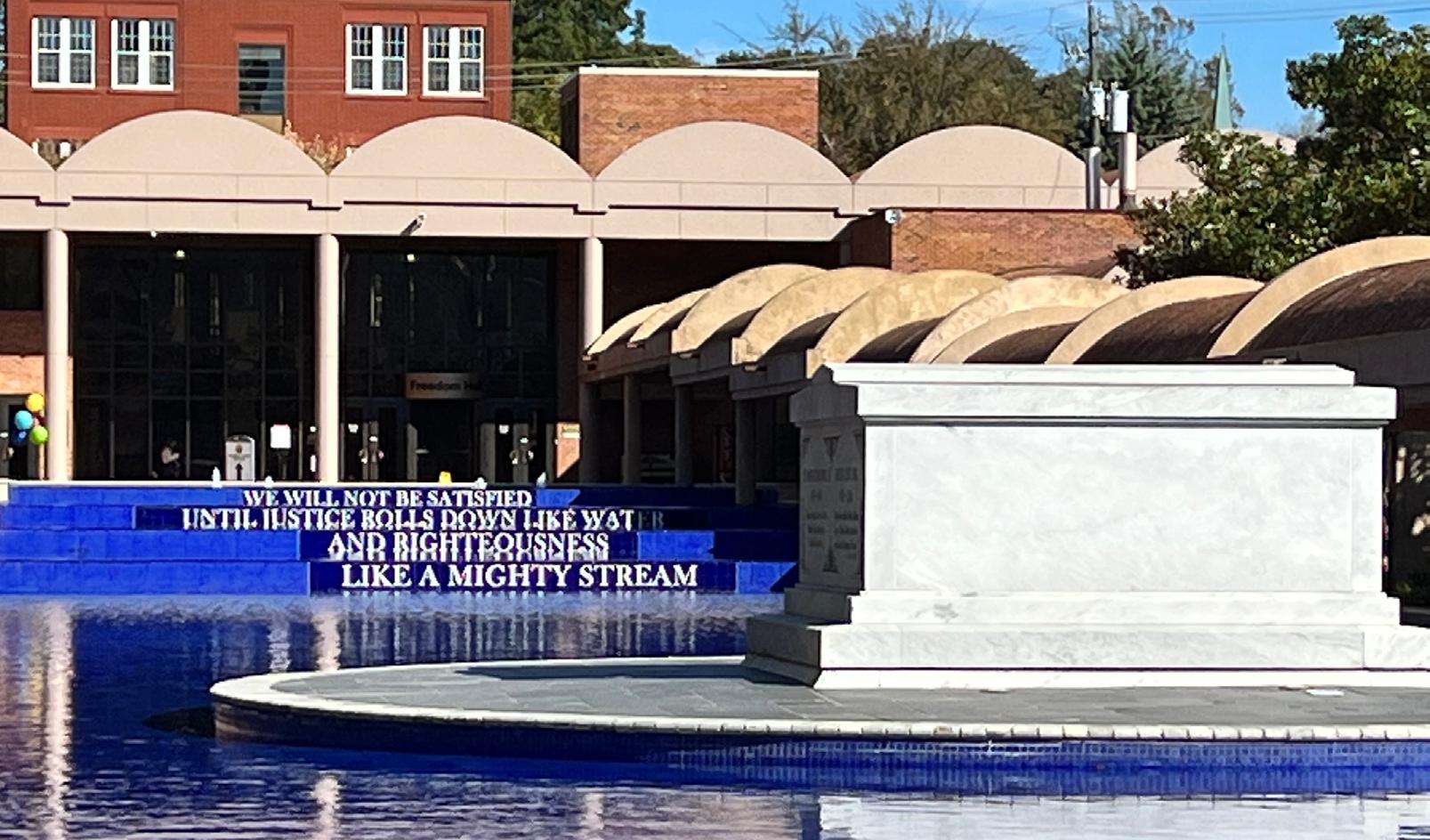

23 ATLANTA AFTER PROPERTY VOL. 2
ATLANTA:

DAY 02: Friday, Oct. 21st, 2022
Artist Studio: Yanique Norman
Westview Studios, Suite 302, 1450 Ralph David Abernathy Blvd Atlanta, GA
High Museum of Art:
High Museum of Art, 1280 Peachtree St NE, Atlanta, GA 30309
Panel Discussion
Haugabrooks, 364 Auburn Ave NE, Atlanta, GA 30312
Panelists: Yanique Norman, Dani Brockington, Jasmine Bernet, Sarah Al-Khayyal, Charmaine Minniefield, and LeJuano Varnell
Lauren oversees the African which includes masks and beadwork, metalwork, and As a scholar and curator, she African political and economic through the lens of cultural ining the spatial history of tistic practices within the the Atlantic.

Panel Discussion
The diverse set of panelists share their insight on what Blackness means, reflecting on new ways of thinking and living to shift towards a new found spatial agency.
The conversation delves deep into existing power structures, and raises questions about the possibilities of resisting the regime of neoliberal capitalism from within, by co-opting the tools of the same short-sighted regime. Further dialogue on each site prompts the students to reframe perspectives on Atlanta After Property.
 Lauren Tate Baeza Fred and Rita Richman Curator High Museum
Lauren Tate Baeza Fred and Rita Richman Curator High Museum
24 FALL 2022
Yanique Norman
Atlanta-based Artist
“Black fungibility is an alternate ideological dream model” that tethers Black experience with scientific and technological actions of organic transmutation, multiplicity, reproduction, and shapeshifting through installation, sound, video, sculpture, and drawings.”
Curator of African Art, African art collection and sculpture, textiles, and ceramics. she has researched economic phenomena cultural geography, examof food culture and arcontinent and across
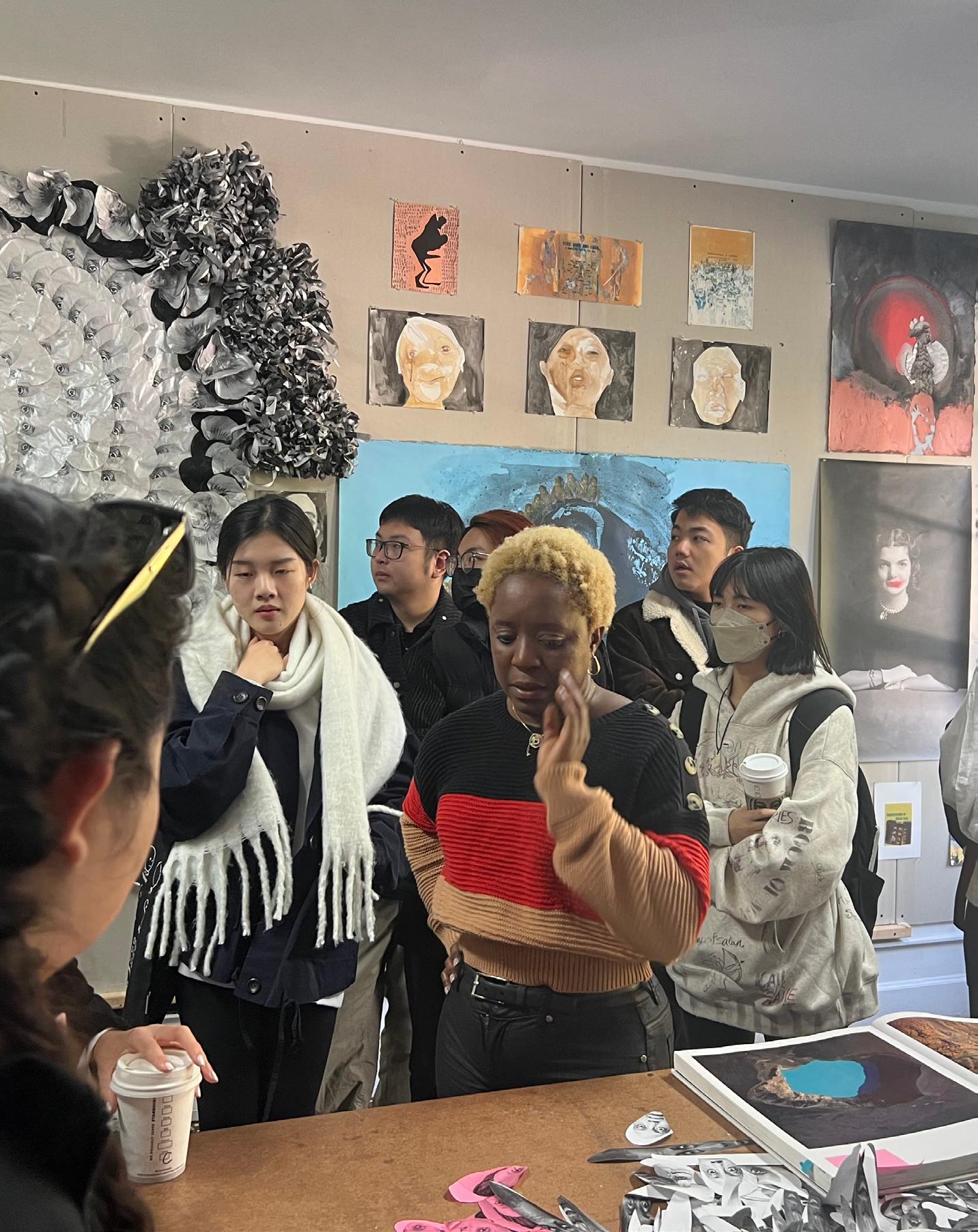
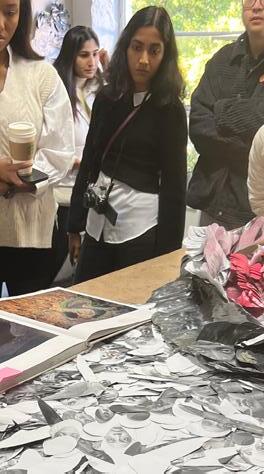

25
ATLANTA AFTER PROPERTY VOL. 2
Friday, Oct 21, 2022
The day starts with an inspiring performative piece on Black Fungibility by artist Yanique Norman. Once a church, her studio space now exhibits different forms of ethereality through the continuous production of radical forms of art.
Yanique takes the students through her process and experiences working with various media. At the center of her work, she questions and reframes what it means to be a Black woman in the American south, particularly

in Atlanta.
Our visit with Yanique is followed by a tour of the High Museum where her work is on display.


The Museum houses works of Atlantan artists who push the boundaries of representation both in terms of what is shown, and how it is shown.
Profound stories lie behind the creation of each piece at the Museum. The curation of each collection a careful, measured composition.
Of particular interest to us is the African Art collection. Curated by Lauren Tate Baeza. It hosts historic ritual objects and stunning sculptural pieces from the African continent, as well as modern artists’ works.
El Anatsui’s Taago entrances us all at once. It’s rigid and malleable, meticulous yet whimsical,

holding deep knowledge in its luminous folds.
Lauren explains some of the intricacies of what it means to curate African Art for the High Museum, and how she plans to steer this narrative going forward.
26 FALL 2022
The Haugabrooks Funeral Home was established in 1929, by Geneva Haugabrooks. It quickly became one of Atlanta’s most successful Black-woman owned businesses, and significantly contributes to Black life in the city by supporting business ventures, Black rights groups and many other philanthropic initiatives.
Today, it is a commercial meeting space and gallery. The panel discussion happens in this hallowed space on Auburn Avenue.

The panel is composed of experts from a diverse array of fields including the performing and visual arts, social activism, urban planning, architecture, and policy

making. Together, they weave a powerful image of Atlanta’s present reality and how we can move towards a radically reimagined city.
Drawing from historic practices of resistance and resilience, they speak of an abolitionist, anti-displacement future based on systemic reparations and progressive tactics to achieve a sustainable, long-term ‘commons.’
They leave us with thoughts of what it means to create restorative systems instead of punitive ones, and the deep significance of working from a sustainable and holistic perspective rooted in mutual trust, instead of a short-term, top-down, solution-based approach.

27 ATLANTA AFTER PROPERTY VOL. 2
ATLANTA: DAY 03: Saturday, Oct. 22nd, 2022

Site Visit with The Guild
MARTA to site is 28 minutes
1st Project - 918 Dill Ave Sw, Atlanta, Ga, 30310
2nd Project - 1187 Ira Street Sw, Atlanta, Ga, 30310
Team Site Visits
The Guild - Site Visit
Antarkish Tandon
“The idea with each of our projects is that the neighborhood, the stewardhip trust and residents gradually build ownership, and the local economy is strengthened in a stable and sustainable manner.’
A pleasant walk from the Oakland MARTA Station takes us through residential neighborhoods composed largely of single-family homes. Antariksh from The Guild greets us at the first site, a corner building that was once a grocery store. He shares with us the organization’s vision for more equitable and communal forms of ownership, while also pointing out the trials of working towards such a model from within a capitalistic framework.
Devising methods and tools to subvert the regime using the mechanisms of capitalism feels like a an exciting but arduous task. Antariksh fields question after question as we converse our way to a better understanding of this vision of an After-Property. A longtime local resident joins us and is invited to The Guild’s next gathering to learn more about what they can do for his community.
28 FALL 2022




29 ATLANTA AFTER PROPERTY VOL. 2
ATLANTA: Day 03 |Team Site
The Peachtree Downtown Center epitomises John Portman’s vision for the city of Atlanta. It is a textbook example of interior urbanism, which separates the district from the rest of the city.
The closure of multiple locations of the Wellstar Health Center is a symptom of Atlanta’s apathy towards holistic and inclusive healthcare, which should be a universal human right.

The Mercedes Benz Stadium is among Atlanta’s most prominent efforts to rebrand the city as a modern destination for sports and a cosmopolitan consumer culture.

Located at the junction of several contending forces of capital, Hulsey Yard is a vast concrete void separating historically intertwined neighborhoods and communities.


02 | Mercedes Benz Stadium 04 | Hulsey Yards 03 |Wellstar Health Center 01 | Peachtree Town Center 30 FALL 2022
Visits:
Peoplestown is where the forces of capital have long taken advantage of poor planning and the ravages of nature, to seize homes and property from the hands of those who can least afford it.
Built upon bonded, inhumane labor, the Chattahoochee Brick Company has witnessed deep injustice meted out upon the enslaved, the incarcerated, and the land itself.


A mall that has long centered community, from its heyday to the present, where it has transcended its role as a shopping destination to become an icon of Black culture in Atlanta.
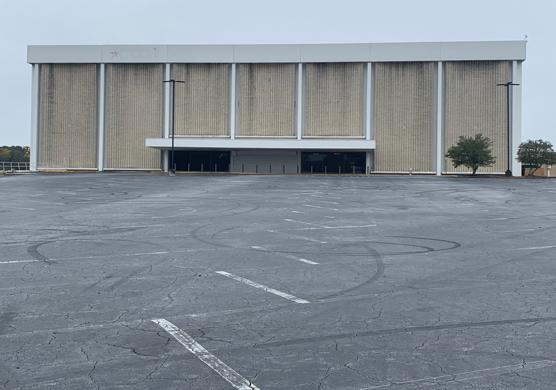
With the commodification of cultural production in Atlanta, the ‘City in the Forest’ is set to swallow the very forest it is set in a bid to further the city’s brand as a showbiz destination.

06 | Greenbriar Mall 08 | Blackhall Studios 05 | Peoplestown 07 | Chattahoochee Brick Company 31 ATLANTA AFTER PROPERTY VOL. 2
ATLANTA:
Day 03 |Team Site Visits:
09 | Techwood Homes
The city’s short lived commitment to public housing programming is clearly seen at the Techwood Homes complex, the site of many a broken promise and failed mandate.

11 | Forest Cove Apartments
Abutting one of the city’s numerous carceral complexes, Forest Cove Apartments has a complicated history entangled in policing, incarceration and layered forms of surveillance.

10 | Greenwood Cemetery
Segregation, property and commodity exist beyond even death. The Greenwood Cemetery is a stark reminder of the fact that we live and die within vicious cycles of property.

12 | Olympic Stadium, Summerhill
The Olymic Stadium reveals Atlanta’s desire to brand itself a destination for some of the most prominent events in human history at the cost of its own people’s lives and livelihoods.

32 FALL 2022
13 | Downtown Parking
The multiple concrete islands of parking lots and buildings in Downtown Atlanta exhibit one of the most elemental tenets of the property regime where possession is prioritized over people.

33 ATLANTA AFTER PROPERTY VOL. 2
How can we disentangle urban design and architecture from property?1

How can we use this moment of environmental and institutional reckoning to disassemble the exploitative regimes of speculation and displacement that anchor the built environment?


In other words, where do we go from here?
Our next step is to design a region (with hopes of building a world) that is not tethered to
individual land ownership, but instead, predicated on collective stewardship and care. This work will be done by recognizing ordinary spatial practices that operate against the hegemony of real estate. Through radical reinterpretations of historical and contemporary interventions where the everyday struggle begins to approach the surreal, we aim to liberate urban design from its historical commitment to borderization.3
We will celebrate undervalued spatial practices that actively dismantle the Cartesian frame of racial capitalism, as a gathering of performances committed to imaging a different world, because the status-quo is untenable.
34 FALL 2022
ATLANTA:
DAY 04: Sunday, Oct. 23rd, 2022


ITINERARY:
Studio Breakfast + Debrief
GSAPP Departs

The High - Field Trip!
35
ATLANTA AFTER PROPERTY VOL. 2
PROJECTS
The final project is an accounting of the research and design decisions that generated each team’s vision of Atlanta after property. The aim is to design a region (with hopes of building a world) that is not tethered to individual land ownership, but instead, predicated on collective stewardship and care. This work is done by recognizing ordinary spatial practices that operate against the hegemony of real estate. Through radical reinterpretations of historical and contemporary interventions where the everyday struggle begins to approach the surreal, we aim to liberate urban design from its historical commitment to borderization.
Atlanta After Property re-frames the discipline of urban design by re-imagining the city of Atlanta in solidarity with contemporary movements of Black liberation and mutuality; working against the ruthless policing, dispossession, and displacement of marginalized communities.
36 FALL 2022
01 Peachtree Town Center 02 Mercedes Benz Stadium 03 Wellstar Atlanta Medical Center 04 Hulsey Yards 05 Peoplestown 06 Greenbriar Mall 07 Chattahoochee Brick Company 08 Blackhall Studios 09 Techwood Homes 10 Greenwood Cemetery 11 Forest Cove Apartments 12 Olympic Stadium 13 Downtown Parking 37 ATLANTA AFTER PROPERTY VOL. 2
1. To develop an enclave of resistance beyond privatized enclosure working towards mutual aid.
2. To render visible the invisible social ecosystems, peoples and patterns of a place.

3. To dissolve objectivity in favor of dynamic, fluid and a multi-perspective way of seeing.
RE-WILDING DOWNTOWN PEACHTREE
PEACHTREE TOWN CENTER
TIPPI
YAOZE YU
MARÍA GABRIELA FLORES
The Downtown Peachtree district sits at the heart of Downtown Atlanta. The large-scale division and dispossession of land alongside typologies of skyscrapers with internal atriums, encapsulate the pervasive forms of property. The legacy of neoliberalism has left future generations with areas such as Downtown Peachtree, which are emblematic of this regime of property, and manifest the relationship between architecture and politics, both involving architecture’s role in the economy, as well as its role as a cultural object.
In its current expression, interior urbanism leaves the city outside. Artificial ecologies are imagined, underserved people are marginalized, and everyday living experiences are suppressed. Individual comfort predominates over collective care.
We envision a future for the interior urbanism of atrium spaces that supplants the oppressive Cartesian regime of property. We reject the current, exclusive, and proprietary building owner and embrace long-term tenure of the land by welcoming the system-
ically overlooked and dispossessed. The unhoused, the housing-insecure, the sex worker, and the student come together in spaces of collective care to re-imagine spaces of transgression, ecology and the senses.
Critical of the current trope of sustainability, we embrace a multi-temporal understanding of spatial relations in order to develop an enclave of resistance beyond privatized enclosure working towards mutual aid. Our aim is to render visible the invisible social ecosystems, peoples and patterns of a place. We position ourselves as the ‘anti-developer’ developers!
 Behind the Facade Queering of the City
Non-extraction Sonoran Desert Foraging
HEER SHAH
HUANG
Behind the Facade Queering of the City
Non-extraction Sonoran Desert Foraging
HEER SHAH
HUANG
38 FALL 2022

This building can be explored more deeply in terms of carbon output and temperature. The building will start to have a mixture of textures as the users begin occupying the space.
Provocation can be explored in a deeper way between the interior and exterior of the building. We shut off the air conditioning system of the building and start to create comfort across the building by introducing water, vegetation, ceiling fans etc.
In a world after property, we embrace comfort, the existing, the temporal use of activities and let the happenstance of the city into Portman’s top down built environment.
[1] Collaged vision of ecology in Portman’s building



[2] Conceptual scene at night in Portman’s building
[3] Vision of collective care in Portman’s building
[4] Elements occupying Portman’s building

[1] [3] [2] [4] 40 FALL 2022

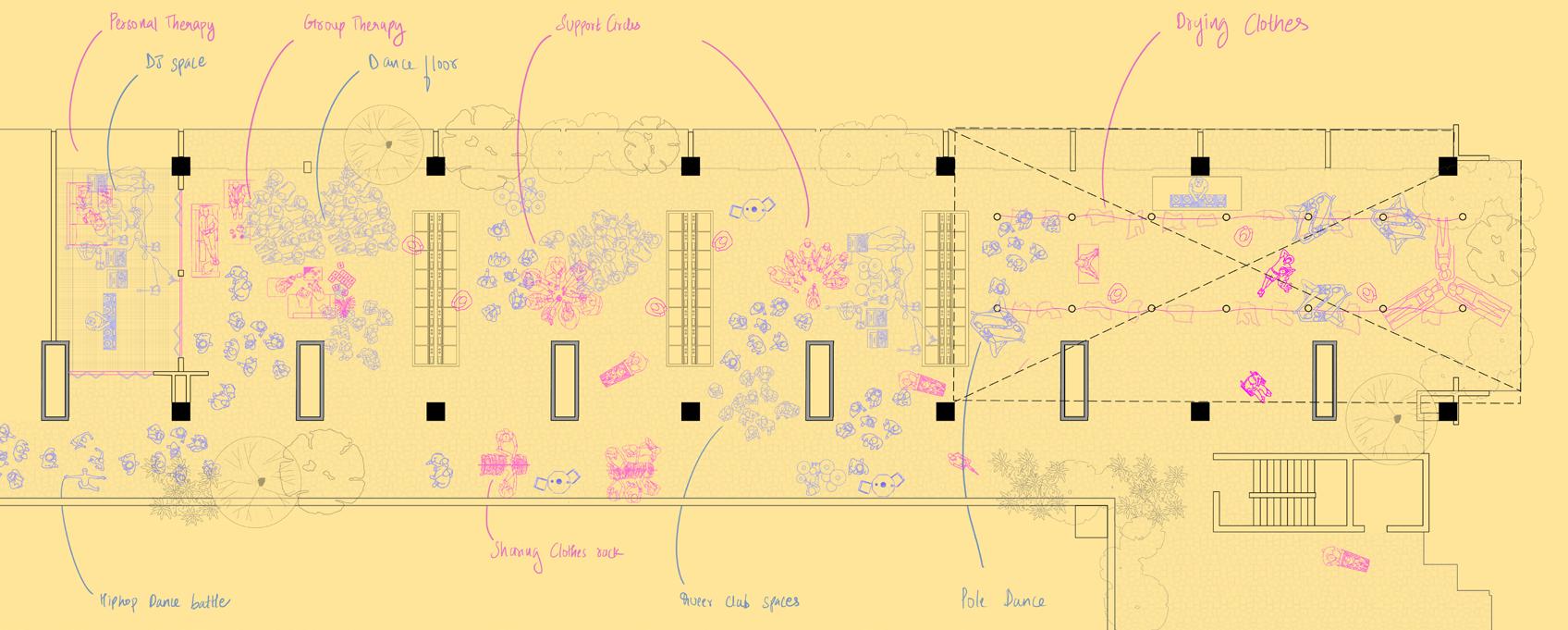

6F
12F
18F
Plan
Plan
Plan

FALL 2022 Scenarios
42
of Atrium in Portman’s Building
To break up Portman’s current enclosure, we have adopted the concept of foraging. We observe the natural existing conditions and like the foragers find possibility even in the smallest of the things. We identify these elements from across Atlanta. These elements will be used in hotel buildings and exterior street spaces to form new social ecosystems.

We envision the after property of the hotel district through turning off the air conditioner and making it open to the city. For the atrium, we intervened with the ramp and vegetation. The ramp can clearly guide the sequence of public spaces, and the vegetation can make it a natural place with high living-quality.

ATLANTA AFTER PROPERTY VOL. 2 43
Conceptual model of simulated atrium intervention.


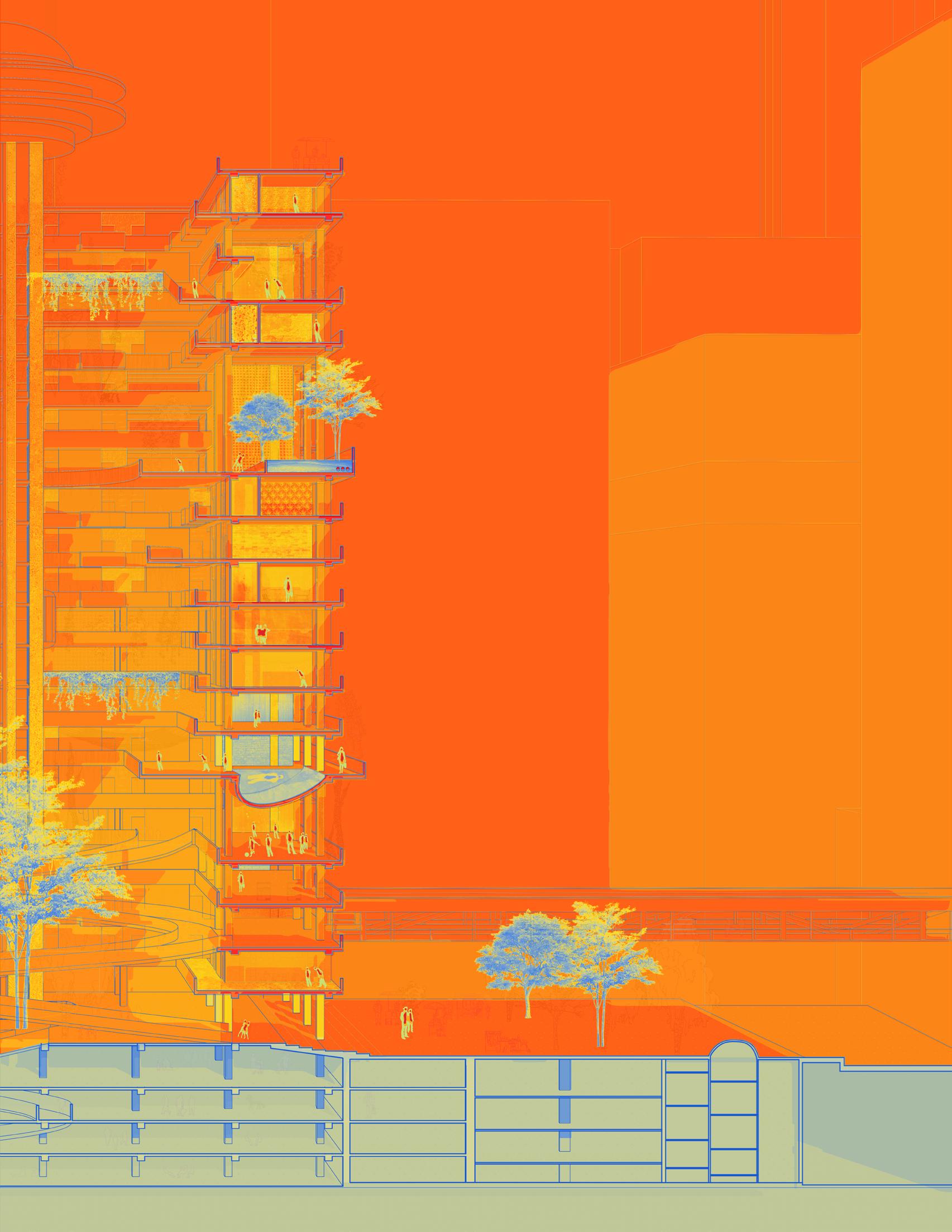
Temporal Shifts
Wuhan Night Market
Proprietorship will be annexed by partnership.

We are against the dispossession of property and land speculation caused by mass media and the commodity-economy spectacle.
We propose new forms of communal living and ownership through authentic means of production and micro-industries native to Atlanta to encourage active relationships.
WOOD SPECTACLE
MERCEDES BENZ STADIUM
CHONGYANG REN
RUXUAN ZHENG
JIANI DAI JACQUELINE LIU
We believe that in current society, property is a framework for social, economic, and political rights that are the critical drivers of intergenerational wealth. It is a form of power. Each individual’s social identity is defined by this power hierarchy through ownership in the possession of time and space.
Since the 1960s, sports have caused a new way of land speculation in Atlanta. Atlanta’s political and economic elite have used sports to boost Atlanta’s national/international reputation as a major and modern city, which would help drive the city’s prospects for business and economic growth. Much of Atlanta’s history and culture was sacrificed in the name of the “Sports Spectacle”.
Specifically in downtown, the Mercedes Benz Stadium as a sports spectacle is assimilating surrounding neighborhoods and excluding residents of low
income neighborhoods. Our outlook for a world after property is that property shouldn’t be a vehicle for individualism that translates into an investment vehicle and wealth-generating commodity. Space is not a zero-sum game where one person’s loss is another’s gain, nor is it a resource that only one person must use simultaneously.

“The spectacle is the part of society that gathers all gaze and all focus of consciousness. It is, in fact, fragmented and conveys deceit and false consciousness. ”
——Guy Debord
Reclaiming Fragments Hehuatang, Nanjing
FALL 2022 46

The living space begins with a base module of 12 feet by 12 feet with wooden panels attached to a wooden structure, providing suggestive ways for the living module assembly, whose spatial arrangements and combinations are based on familial structures and their needs.
With the wood shops acting as nodes with continuous circulation within the neighborhood along with the linear shared porches, the Wood City neighborhood is transformed into a skill-share community around themes of wood learning, training, and self-built housing. After assembling the collective living complex, the residents can live and learn together.

48 FALL 2022

49 ATLANTA AFTER PROPERTY VOL. 2
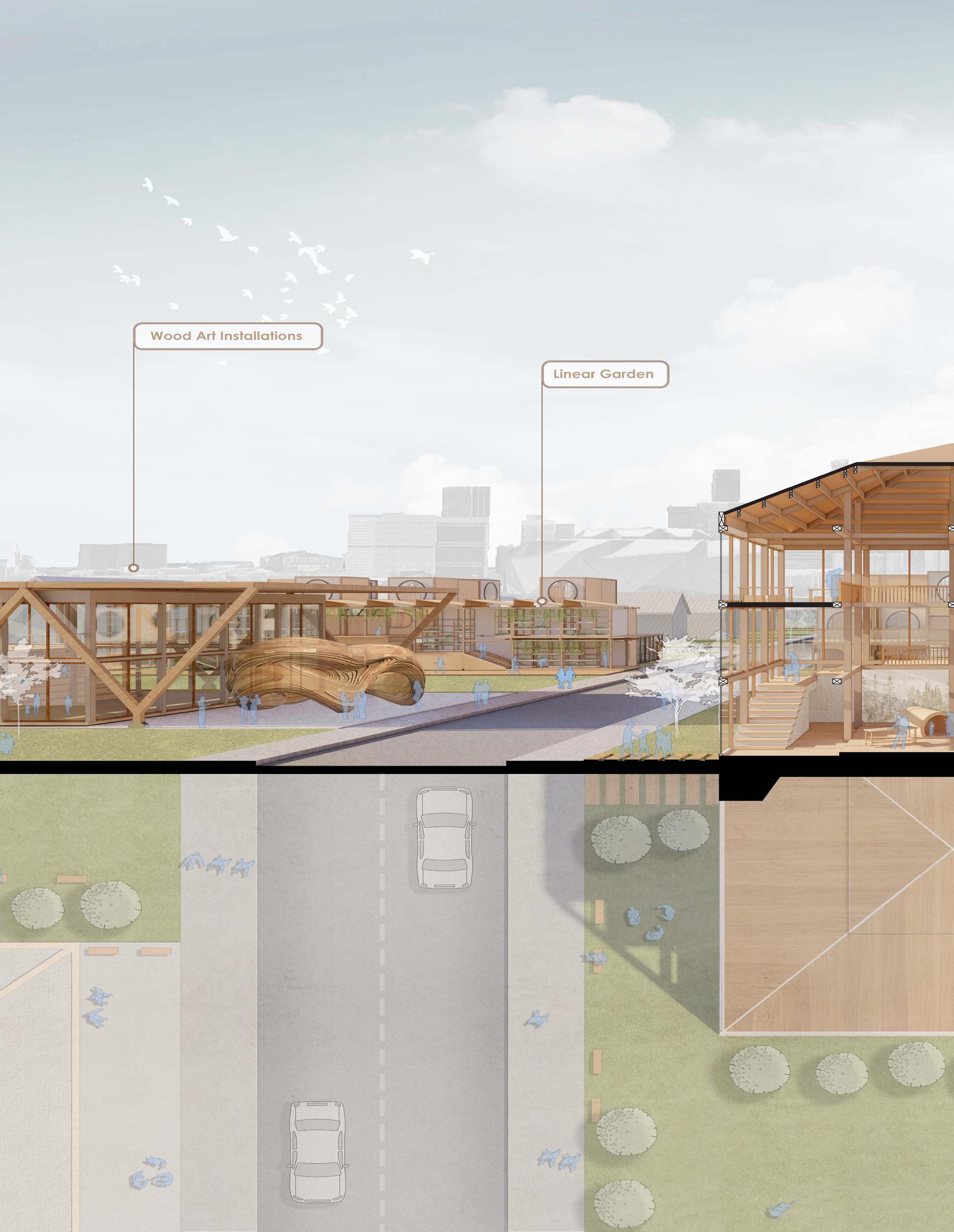





52 FALL 2022
A welcoming area for different groups of people, combining life, leisure, and wood production. Assembling each collective living complex together, the front porch acts as a linear continuation of the shared space, reinforcing the connection between residents through circulation and wooden functional areas.


53 ATLANTA AFTER PROPERTY VOL. 2
Decentralizing health care occurs by strengthening ties within the community, and putting people in power. Widening the focus not only from equitable treatment across a variety of income-groups, but also promoting interaction, engagement and a healthier lifestyle.
It is by the community, for the community and acts as a visceral layer amongst them.”
The diagram on the right explores a decentralized healthcare system that is rooted around you within existing paradigms of churches, schools, food centers, community programs etc.
HEALTHCARE AFTER PROPERTY
WELLSTAR ATLANTA MEDICAL CENTER
Within the bounds of one’s home, health is a value system. It is in the soup brewed with herbal garnishes, a hot cup of tea with ancestral decoctions (Kaadha) and the raised calls of a loved one when you walk out the door on a windy night, without a scarf.


It is within this care of social communities and the knowledge that generations of ancestors above us partake in, where such a value system exists. But somehow, when this system broadens to the scale of a city, it is devoid of dialogue and tangibility.
Homes become hospitals, people become patients, treatments are limited to syringes, tests or pills and all exchanges are about “Registration,” “Insurance,” and the inevitable, “The doctor will see you soon.”
You move around from department to department, while a series of medical professionals
follow a routine - Blood pressure - Heart beat - Temperature. Inquiries to the sound of “So what brings you in today?” The very same question you will hear repeatedly for the next 24 hours as you wait long hours navigating through the organizational hierarchy that healthcare is today.
The institutional system of treatment restricts basic communal access and a programmatic approach to physical and mental well-being. It puts pressure on one central node, linearly within property, while manifesting the bias of the society it exists in. With a history of every urban system that is privy to segregation, ‘Healthcare within Property’ selectively caters to only a specific population, the rich. And Atlanta is no such exception.
Temporality
Manek Chowk, India
Intimacy
Salmon Toor’s Back Lawn
AASHWITA YADAV ROHIN SIKKA SIMRAN GUPTA NUPUR SHAH
54 FALL 2022




56


[1] [2] 57 ATLANTA AFTER PROPERTY VOL. 2

58 FALL 2022
[3]
The entire network was split into typologies that were generic to Atlanta. Single-family homes, Apartment complexes, Supermarkets, Churches and Schools. To these we added our lens of care, where residents could engage in healthy eating habits, recreationally express themselves and as a community support the vulnerable.

The other two typologies were built into the fabric, reclaiming dilapidated or vacant buildings as healthcare centers or an urban farm [1] [2] [3]

Recasting the Image of Care: Taxonomy Chart of a Care Network
Acknowledging intimacy in Urban Scale Healthcare
The neighborhood layout of the healthcare network, as seen with transportation and various scales of intervention.
59 ATLANTA AFTER PROPERTY VOL. 2


After property strips all notions of value from speculation, hoarding and exclusionary forces. It is based on community, collaboration and every human being’s inviolable right to shared knowledge, resources and opportunities. This world is realized through the very tools that the regime of property shaped for itself.
DE/NETWORK
HULSEY YARD
DONNAL BAIJNAUTH
XU (CHELSIE) CHENG
HAOYU HU
The regime of property upholds possession, exclusion and control as markers of value. It reinforces these notions through the cyclic creation of borders and institutionalized barriers to the most fundamental human rights, housing, education, food and opportunity. The MARTA and later the Beltline envisioned a unified city, with everyone having access to housing, and every resource that this city has to offer. The realized mass transit network of metro Atlanta is a far cry from what was promised. The MARTA lines simply highlight the divides of race and economy, while the Beltline ousts those most vulnerable to gentrification.
Hulsey Yard lies at the junction of these two elements. Bordered by some of the most exclusive and fastest gentrifying neighborhoods in the city, the Yard is a vast void owned and operated by railroad giant CSX. There are several contesting

forms of property at play here. There are armies of cookie cutter homes and formulaic mixed use developments along the scar of the Beltline surround the heavily borderized and closed off yard. The city works to keep low-income, unhoused and historically marginalized people out of sight, with society’s amnesiac nature enabling authorities to perpetrate cycles of violence.
How do we begin to address this failure on the city’s part? We look at notions of value to envision Atlanta beyond borders. We question the legitimacy of these systems of value that thrive on exclusion and discomfort. We base our vision on a social value system that puts human needs above all else. We encourage people to take what they need, without hesitation, and share what they can, freely and joyfully. We thus revalue human systems by devaluing the forces of capital.
 Intangible Crossing Mexico-US Border
Outdoor Living Rooms Dharavi
ANAGHA ARUNKUMAR
Intangible Crossing Mexico-US Border
Outdoor Living Rooms Dharavi
ANAGHA ARUNKUMAR
62
2022
FALL






[1] 64 FALL 2022
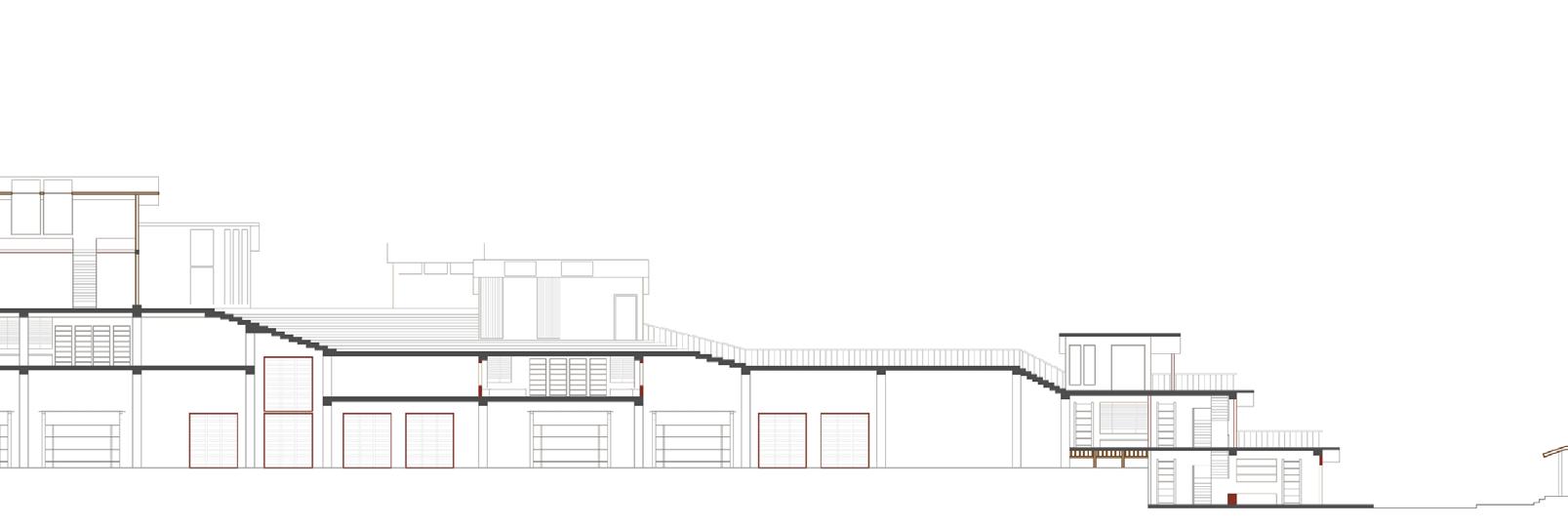

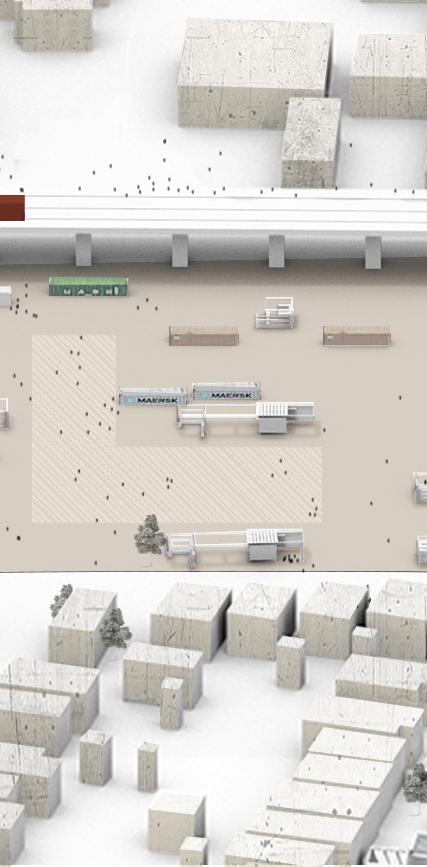

65 ATLANTA AFTER PROPERTY VOL. 2


[2] 66 FALL 2022




[3] [4] 67 ATLANTA AFTER PROPERTY VOL. 2
Vacancy to Shelter: Beltline

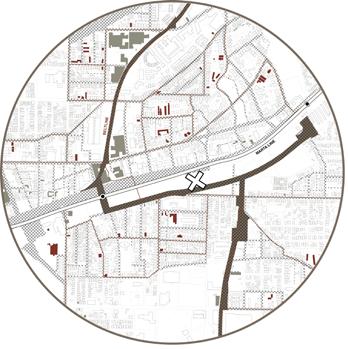
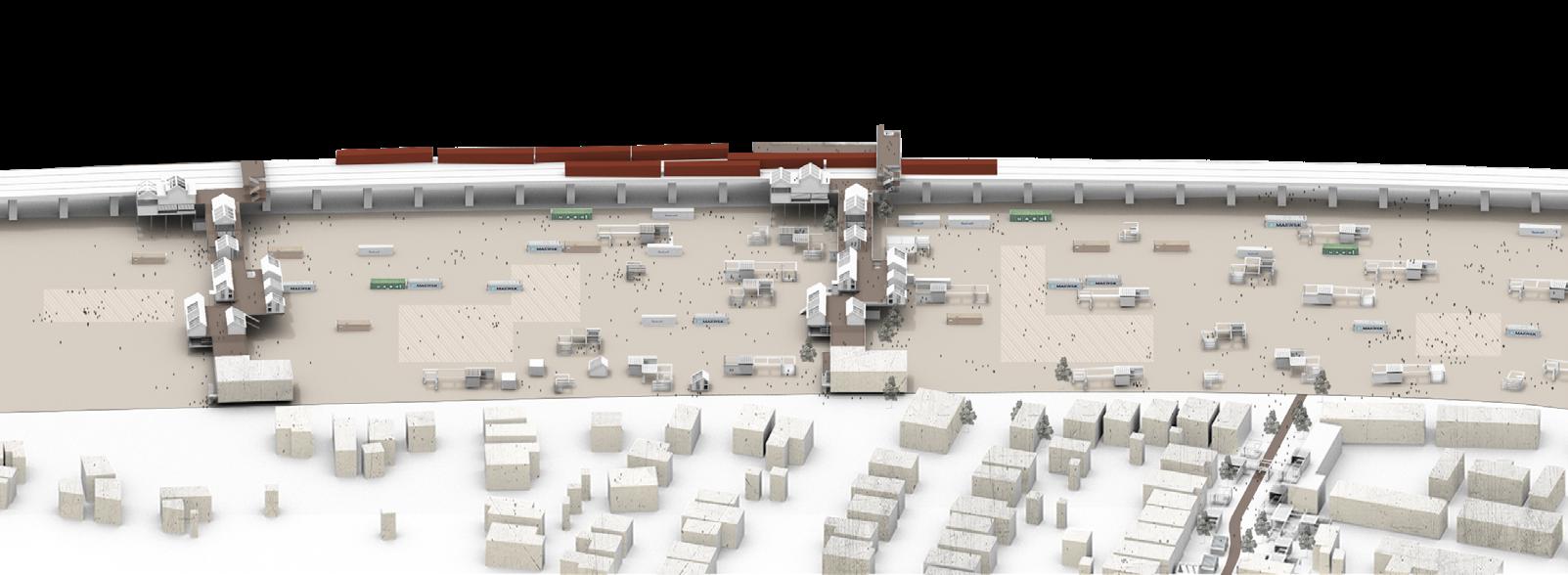
Vacancy to Shelter: MARTA

68 FALL 2022
The regime of property upholds possession, exclusion and control as markers of value. It reinforces these notions through the cyclic creation of barriers to the most fundamental human rights: home, education, food and opportunity.
In our project, we provide access to resources that enable people to learn, develop their skills through independent study or exploration, and engage in forms of unconventional collective learning and training.
Exposing Forces of Capital and Connecting Neighborhoods
Typologies: Sections and Perspectives Structures for the unhoused.


Perspective View, Making and Market
Perspective View, Gathering and Leisure
69 ATLANTA AFTER PROPERTY VOL. 2
[1] [2] [3] [4]
Republic of Rose Island Adriatic Sea, 1968

In a world after property, water is as an agent to liberate spaces and encourage a network of vegetation and non-human logics. Tracing roots is an appreciation of aqueous beginnings. It exposes the temporality, uncertainty and complexity of the places we inhabit. It is both a fragment and manifest to create a co-constitutive relationship with water.
TRACING ROOTS
PEOPLESTOWN
YASHITA KHANNA VERENA KRAPPITZ
Water holds the past and present. Deciphering it´s layers, it mirrors decisions and the way land is acquired. The way current practices respond to water is defensive and results in impervious soils that redirect water somewhere else, destroying resilient networks and causing harm to the ones most vulnerable. These floods are consequences of a white governed property regime that has worked steadily towards the dispossession of people for the sake of western economy. It is undermining people’s intimate relationship to bodies of water; both natural and artificial.
Atlanta is a city of water, sourced from ranges of the Appalachian Mountains and occurring rainfall. It sits on the mountain ridge of two watersheds. The land lies on a thick granite foundation, holding rich groundwater reservoirs. Yet Atlanta´s soil contains a lot of hard clay, which makes the infiltration of water
difficult. Instead, the water tends to quickly run off to lower grounds.
“Tracing roots”acknowledges the presence of water and re-imagines new conditions along sealed grounds in the watershed. Water is multiscalar and immeasurable and as such destabilizes conventional planning practices.
The diagram on the left shows a series of sections through the Intrenchment Creek Watershed in Atlanta. The existing built environment is marked in white. Water erodes property lines in the sealed soils, marked in gray.
The water flow is decentralized, through the increased permeability of vegetation, which creates water sensitive typologies for future generations. Over time, more water is able to be absorbed in place, relieving both low lying areas as well as existing gray infrastructure.
 NAUMIKA HEJIB
DEVANSHI GAJJAR
Open Grazing in Ado Awaye White Oak Pastures Farm Stay USA, 2022
NAUMIKA HEJIB
DEVANSHI GAJJAR
Open Grazing in Ado Awaye White Oak Pastures Farm Stay USA, 2022
70 FALL 2022





[1] 72 FALL 2022
[1] [2] [3] ATLANTA AFTER PROPERTY VOL. 2
Cracks in asphalt are evidence that the land is already pushing back. We take advantage of asphalts characteristic to crack. In a world after property these seeds grow into full grown orchards where people collectively care for land and water. In a communal effort the structure evolves. Simultaneous field operations happen over time building a foundation for community growth in a co-constitutive relationship with water.
Generations preserving a foundation of precious root networks

Spaces

of communal care and living

[2]
[3]
An appreciation of aqueous beginnings 73
The collective care of water builds a new foundation. In additon, the rebar is anchored into the bedrock surrounded by a continuously hardening mycelium layer, which supports the topsoil. Additional support comes from several layers of rammed earth which have different absorbency levels. They incubate the grounds and are constantly rebuilt and reshaped. Over time, these foundations evolve into domestic spaces. They are home to multiple forms of creating, sharing, caring and living where water is embraced as a communal value to collect, nourish, filter and recharge.

74 FALL 2022

75 ATLANTA AFTER PROPERTY VOL. 2


Property is reflected through capital-driven shopping Malls, that for a time, can bring the illusion of improvement to a community. A short lived boom, used and controlled by capital, and disappearing with its decline, during which any activity in its space that disturbs the interests of capital is repulsed. Its presence occupies a premium space that could have been used for more beneficial community care and development.

GREENBRIAR PALACE
GREENBRIAR MALL
WENJUN ZHU
HAOYU ZHU

HONGFENG WANG QIANNAN GUO
The suburban shopping mall is “property” built for the consumption and lifestyle of the American middle class. The design philosophy and operation of the shopping mall was created to maximize profits and economic benefits in the shortest amount of time. However, with changes in peoples’ lifestyles and the emergence of online shopping in the twenty first century, the traditional shopping mall has gone into decline.
Although malls are dying commercial spaces, they are currently being used to attract people who were once overlooked or even rejected by them. Those who did not have the ability to spend but were active in every corner of shopping mall spaces: teenagers and youths. Shopping malls are one of the few safe recreational spaces in suburban communities for youth, who typically live far from thriving urban centers.
Unfortunately, most shopping malls over the last century still believe that the activities of young people in the mall are reducing the revenue that the mall can generate. They are unable to provide spending that is proportional to the time they spend shopping. Much of the youth has been driven away from the malls. We question whether this approach of breaking up kid’s groups and restricting where they can go is justified?
Instead, we claim that all malls in the US should encourage and support the social learning and leisure activities of the youth, especially for communities that lack safe public spaces for youth activities.
By infusing new and dynamic programs, dead malls have been transformed into places for young people to learn, play, and socialize. The traditional sense of a mall built for capital interests will be transformed into a youth paradise.
Wangliao Fishing Village Chiayi, Taiwan
Shanty Town Suzhou River
78 FALL 2022
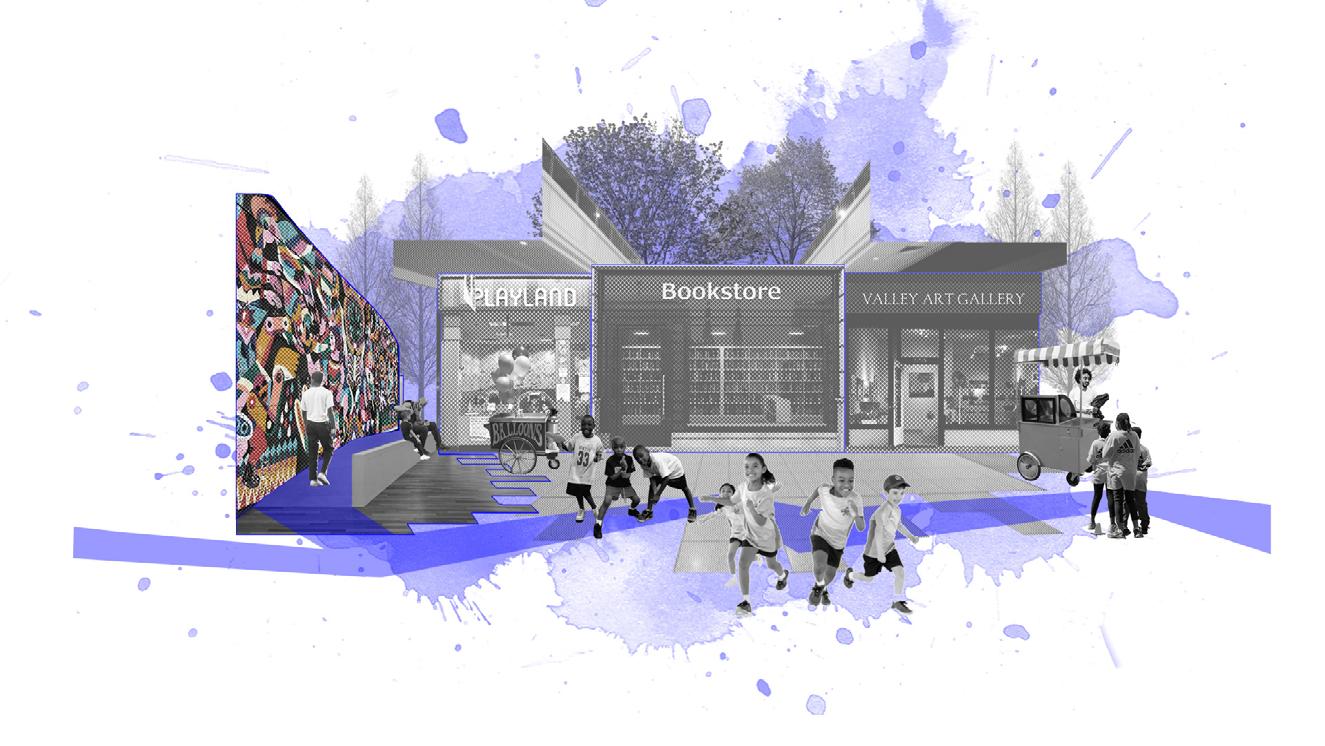


Far from downtown, Greenbriar is a community that is full of vacant space but lacks safe recreational spaces. Greenbriar Mall could be a space that serves this function. However, with white flight and the loss of a large population with the capacity to consume, capital abandoned Greenbriar mall and the once thriving mall has seen a decline.
In addition, Greenbriar mall’s extremely large parking lots, I-shaped interior circulation, and inward-facing storefronts suggests to all that it is an exclusive, car-oriented consumption space.

Furthermore, because of the lack of educational resources and safe spaces for youth, the youth in the Greenbriar community are more likely to be misled and even in danger than other youth in wealthy communities.
Although, Greenbriar mall was considered hopeless, the youth of the community slowly began to occupy the vacant spaces with performance and school activity spaces. With their return, Greenbriar Mall plays a central role for the youth while still maintaining it’s identity as a “Hood Mall.” It has since inspired our new vision for Greenbriar mall as a place for youth social activity.

80 FALL 2022





81 ATLANTA AFTER PROPERTY VOL. 2




82 FALL 2022
Our project embraces the idea that the youth’s opportunity to learn and communicate should not be tied to the confines of a classroom. Having this opportunity to learn outside of the traditional, social framework, allows for the integration of youth programs while at the same time, encourages existing social and cultural activities and the relationships between the mall and the community to thrive.
We propose a Greenbriar Palace as a multi-functional structure to accommodate youth activities attached to the existing mall structure.



The Greenbriar Palace connects the mall to it’s context. Connecting the nearby charter school and beyond, towards Atlanta’s greater communities and neighborhoods. Instead of walking through a large, boring parking lot, full of safety concerns, the youth can make their way through a dynamic space to enter the mall and school, especially for the youth who don’t own a car. By improving the mall’s walkability and accessibility, the original exterior space is transformed to feel much more secure.
Greenbriar Palace will also slightly change the flow and appearance of the mall. The I-circulation, which was originally designed for quick consumption and customer movement, is interrupted by Greenbriar Palace by enclosed gathering spaces. In addition, inward-facing store fronts are changed to more outward-facing storefronts with a glass covered façade.
83 ATLANTA AFTER PROPERTY VOL. 2
84 FALL 2022
[1] [2] [3] [4] ATLANTA AFTER PROPERTY VOL. 2
Our main take-away is that no matter how hopeless the capitalist regime perceives this “ dead” mall to be, Greenbriar Mall will continue to maintain its identity as a “Hood Mall” by the community. Its value is not based on how much economic profit it can produce, but the ways it provides the community and the youth a sense of identity and place, connections which property cannot take away.
Current I-Shape Circulation
Proposed Multi-Gather Spaces Circulation
Current Enclosed Inwardfacing Unit Front
[1] [2] [3] [4]
Proposed Open Outwardfacing Unit front 85
“This is a monumental step in transferring land ownership with a history of pain and injustice and placing it in the hands of the people of Atlanta.”
In the world after property, the notions of ownership and hierarchy are no longer present. After property is where shared memories recreate tangible and intangible forms of the ongoing future and is no longer a static entity.

MAKING AS HEALING
CHATTAHOOCHEE BRICK COMPANY
ANCHALINAD ANUWATNONTAKET
HANFEI FU
MINGRUI JIANG
XIUTONG YU
After the Civil War, Black Southerners were no longer enslaved, but they were not yet free. The Sheriff sold free Black people to corporations and coal mines. For 80 years, thousands of Black people were forced to labor against their will across the country. Atlanta, in the state of Georgia, had a long dark history from 1868-1942.
The Chattahoochee Brick Company used convict labor to produce bricks for the city, including Techwood Homes, Greenwood Cemetery, and Georgia State University. Its bricks were distributed to build the sidewalks, streets, and homes in Atlanta and across the United States. For decades, prisoners were forced to do unpaid labor at this brickyard. Through many years of struggling with property, the site finally belongs to the city of Atlanta. It is now time to recollect the lost memories and piece the stories together. Using remembrance as resistance,
we plan to use memorializing activities to excavate and discover the underground and on-ground memories. People will engage with the earth, remediate the land, and recreate new memories together. Through ‘Making as Healing,’ we remediate the spiritual and physical harm done to humans and the earth through material practices.
Our strategies of healing are inspired by the characteristics of the site. We are using raw materials and nature to heal social and ecological traumas: contamination, degradation, flooding, and the legacy of slavery. People have the opportunity to make and create with their hands, to engage in the practice of healing over time. With multiple fabricated realities, this after-property world will be seen as transcribing history and memory based on the cultural understanding of materials, plants, and spaces.
 Koliwadas The Extension of Jugaad
Candle Vigils Remembrance as Resistance
Koliwadas The Extension of Jugaad
Candle Vigils Remembrance as Resistance
86 FALL 2022


[3] 88 FALL 2022
Touching and feeling from the cold concrete, to soft clay and soil, then to the florid brick, dynamic water creates immersive atmospheres for making activities.

Directly or indirectly, visitors use all the materials produced from these processes, build new architectures, and make handicrafts to heal traumas existing on-site and in their memory.
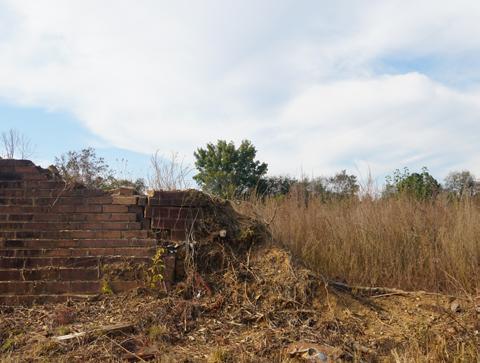
 [3] Rediscovery of the underground and on-ground memories.
[1] A dilapidated brick wall on site.
[3] Rediscovery of the underground and on-ground memories.
[1] A dilapidated brick wall on site.
89 ATLANTA AFTER PROPERTY VOL. 2
[2] Vicissitudes textures reflecting a scarred and heavy history


[4] [5] 90 FALL 2022
The earth will keep growing and developing with nature and human power. With its multiple fabricated realities, the site will be seen as the transcription of history and memory based on the cultural understanding of materials, plants, and spaces. During those performances, the land’s traumas are removed and transformed into something new and beautiful.


Crafting and Creation
Performance-Extracting and Meditation
Engaging with the earth
Plan and Section Changing with Time
[6] [7]
91 ATLANTA AFTER PROPERTY VOL. 2
[4] [5] [6] [7]


Color, Space, and Time
Jodhpur Brahmahpuri

Alex Reynolds, 2021.
After-property envisions a society based on kinship amongst human and nonhuman actors to produce spaces for autonomy, connection, and expression. The forest, reimagined as the wild, becomes a place for the curation of life and production of culture: an expansive, immeasurable condition, and a process that transforms itself into an active agent within the city.
Vision of music production after property
Vision of wetland neighborhood after property
CITY OF THE FOREST
BLACKHALL STUDIO
Property is a social, spatial tool enacted to fortify the regime’s continuum of power and control. Through acts of domestication, preservation, and measurement, land and its inhabitants have been valued as resources to exploit and tame. Spaces deemed “natural” are not pristine landscapes but highly regulated environments that continue to reinscribe the systemic cycles of exclusion, erasure, and precarity.
Atlanta has been rendered as a placeless backdrop by the film industry and a tactical testing ground by the Atlanta Police Foundation. Through the extraction of public resources, flattening of history and culture, and the degradation of the forest and wetland ecologies, the South River Forest has been a site of ongoing trauma since its commodification as property.
Blackhall Studio’s vision for the future of the South River Forest proposes sound stage
expansions that will intensify the imposition of capitalism on the site and erode its ecology as it deforests public land for private development. Direct actions and advocacy against the proposals are being led by community organizations, including environmental activists, forest defenders, abolitionists, and Muscogee Creek descendants.
We imagine future cultural productions throughout metro Atlanta to build toward a vision of spatial and environmental liberation. As components of the city currently weave into the forest, taming and domesticating it, we envision the infrastructures of the forest performing the reverse. Infiltrating the city to de-zone, disrupt and erode the structure of the regime. Spaces of fluidity provide few distinctions between the industrialized built environments.

[1] [2]
Phase Shift- Siachen Glacier Ciril Jazbec for National Geographic, 2020
OREOLUWA ADEGBOLA VIR SHAH REYA SINGHI CAROLINE WINEBURG
94 FALL 2022


[2] [1]


[3] 96 FALL 2022
The forest ecosystem has been devalued by the current system and contained by the cartographer’s lines. Sites most emblematic of the capitalist regime become targets for the forest defender’s escalating oppositions as they enable the forest’s expansion by physically interrupting order and reorienting spaces for heterogeneous habitation. The forest landscape, as it’s always been, is embodied. Distinct boundaries between nature and built form are collapsed and legibility is obscured. The forest transforms from an environment of depletion to an expansive condition, unbound in our radical vision.

Forest expansion along rivers, creeks, and streams. Site Mapping 01, 02, and 03.

[3]
97 ATLANTA AFTER PROPERTY VOL. 2

[4] 98 FALL 2022
[4] [5] [6] [7] ATLANTA AFTER PROPERTY VOL. 2
Community habitation within the forest is re-imagined for spaces of intersection through multi-sensory interventions, which allow the natural environment to flourish and different agents to care for each other. Shifting landscapes create polytemporal spaces for the curation of life, challenging the linear notions of living and enhancing the cultural multiplicities of every day. In the world after property, we imagine the forest to be the central protagonist with cultural activations that defy the extractive regime of property.


Section 01 Intrenchment Creek
Section 02 Soundstage
Section 03 Post-gas station

[5] [6]
Next Page: Forest After Property 99

[7]

After-property is a collective form of resistance centered on embeddedness and belonging. Mutual aid networks create kinship and collective liberation beyond the oppressive system of individual ownership. A world after property is supported by a culture of care.
LIVING NETWORK

TECHWOOD HOMES
Property is the catalyst of a racialized system of perpetual displacement. It is a system that prioritizes and protects security, power and capital. It functions as an alienating framework of private ownership privileging the nuclear family as opposed to collective belonging.
Techwood Homes is the country’s first public housing development and subsequently the first formalized segregation policy. Years of neglect required tenant-led organizing to ensure security, community support, and empowerment. The current luxury townhouse typology, individualized for the single “family,” moved even further away from the dense typology which supports social encounter and culture.
These are our guiding questions for a world After-Property:
Is it possible for stewardship to replace ownership?
Can family expand to communal kinship?
How can there be emplacement and embeddedness after property?
Living Network, imagines a world after property where home is not subject to a monetary obligations, but rather a network of relationships and responsibilities,- a model of collective stewardship that ensures security in place. It is a system of communal mutual aid to ensure embeddedness.
 DEEPA GOPALAKRISHNAN DI LÊ JADE DURAND JOHN GRUNEWALD
Trap House Vicent Desailly
DEEPA GOPALAKRISHNAN DI LÊ JADE DURAND JOHN GRUNEWALD
Trap House Vicent Desailly
102 FALL 2022
Practice of Namaz Contested Territories of Prayer Shukri Sultan


104 FALL 2022
By refusing the single units, walls that divide are surgically removed for sharing. Traditionally prescribed spaces become a mixture of programs.

Breaking beyond the clusters of individual units, these nodes of care seep out into the parking and take form, challenging the developments orthogonal grid, erasing the streets, and spreading into the broader city of Atlanta.
Spaces of stewardship exist within and outside of buildings. Linking to each other, buildings latch on to off-site entities and create a social network of support.

These collages explore relationships expanding beyond the traditional nuclear family, imagining a community transcending the limiting familial tropes.

105 ATLANTA AFTER PROPERTY VOL. 2

106 FALL 2022
Breaking from the nuclear family, in-between spaces manifest and create crossovers between neighbors.
Care becomes a collective effort without diminishing the importance of privacy.
We suggest adjacencies that create spaces of childcare and elderly care through relationships between kids, students, and the elderly as in-between space that could expand. Closeness and visual connectedness form communal responsibility.
Residents can opt into shared living spaces, cooked meals, and collective responsibility for maintenance.

107 ATLANTA AFTER PROPERTY VOL. 2
By grounding local businesses, stewards can live and work on site to ensure rootedness in the community.
People are already living in nontraditional households. AfterProperty imagines a future in which this relationship is embraced and expanded.

108 FALL 2022

109 ATLANTA AFTER PROPERTY VOL. 2
In a world after property, remembrance and memory are not a commodity. A cemetery shall be an everyday landscape of the ordinary; separating it from the institutionalized funeral industrial complex that makes death a commercial practice. To remember or memorialize someone, death is independent of the regulations, by pushing towards collective remembrance, stewardship and responsibility.
THE LAST GREAT NECESSITY
GREENWOOD CEMETERY
Death isn’t expensive, but the socio-economic regulations that are entangled around the rituals related to death, make death or memorializing someone a form of property. A cemetery’s proximity to a neighborhood, the plot, the location of the plot in the cemetery, family burial lots, religious and ethnic group based tombstones and gravestones are just a few physical properties attached to death.

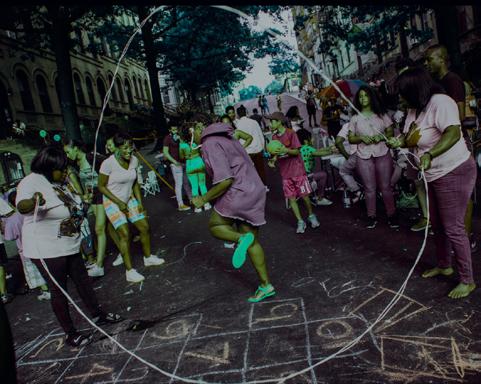
The project ‘The Last Great Necessity’ aims to dismantle the institutionalized funeral industry by subtly deconstructing and de-formalizing its operations. By pushing towards a new landscape aesthetic and moving past the social and physical confines of death, we can create new connections to the city. Reinserting the cemetery into the urban context, while pushing for re-integration of diverse rituals, would bring back the precolonial way of how death and dying are dealt with.
Memorial grounds could invoke a feeling of remembrance only when life and death is in spatial continuity. This is achieved with nature taking over the dead organic matter in the form of a landscape of flowering plants and shrubs, suggesting the continuation of the circle of life. The boundaries of property blur when demarcations are gone. The stone markers and the mowed grass are replaced with collective care and maintenance of the space, bringing in a sense of domesticity to the exterior landscape. People are invited to place objects of the dead to create banal ground of personal belongings.
Fire Hydrants Brooklyn Block Party
Blurring the Edges of Property Delhi6 Film
RUTWIK KARRA DEVANSHI PANDYA YUE HUANG SIWEI TANG
110 FALL 2022



[1] [3] 112 FALL 2022
[1] [2] [3] ATLANTA AFTER PROPERTY VOL. 2
A catalogue of design motifs used for stones across various ethnic and religious groups. These symbols and symbolisms do not represent the life a person has lived.
It is in these everyday objects that their time on Earth is embodied. Why can’t everyday objects replace gravestones?


A ceremony begins with preparing the body, letting family & friends visit before the last rites. A grand marching parade takes the body into the cemetery, with hymns, songs and dance. [2] 113
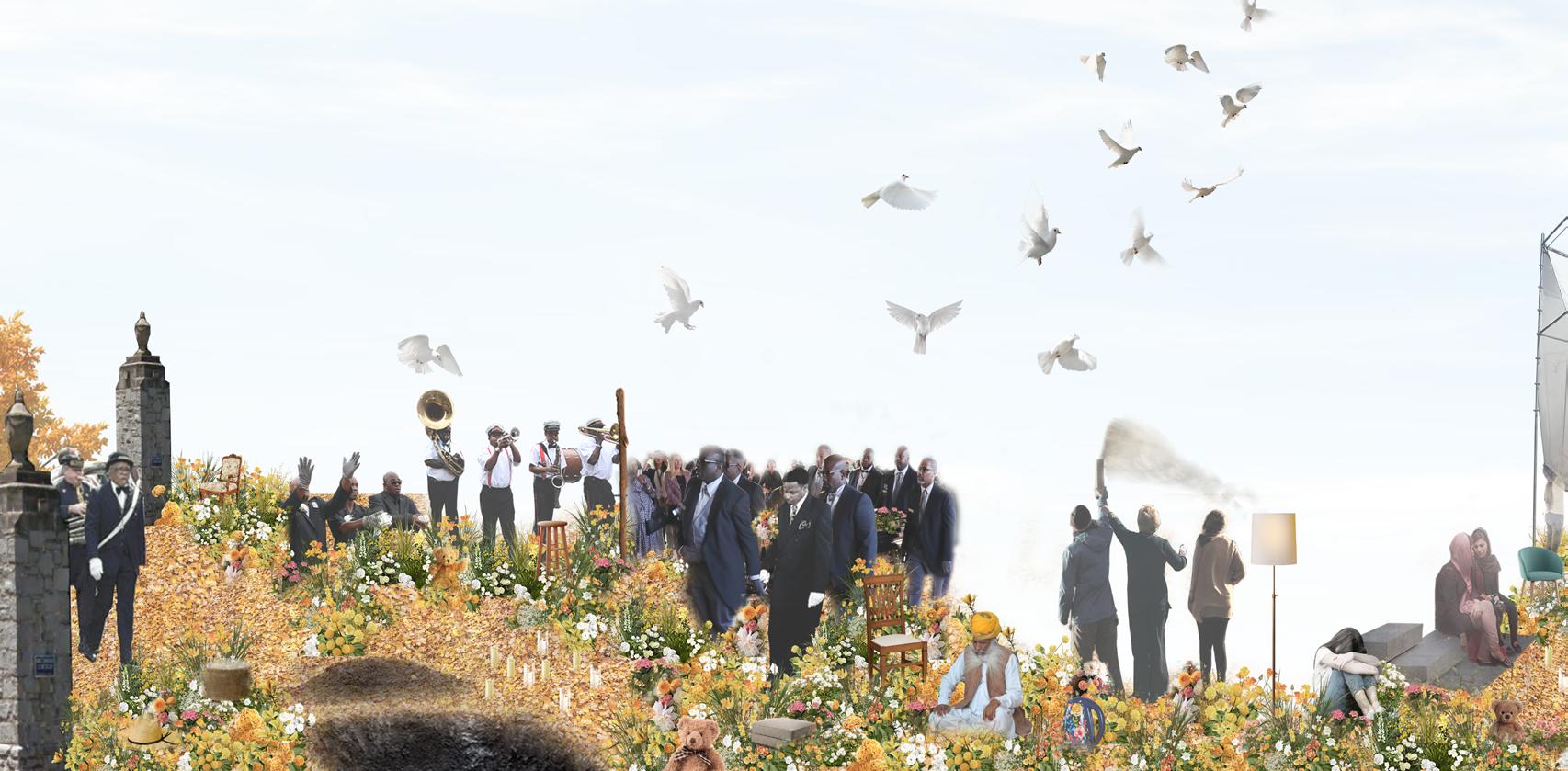

[4] [6] 114 FALL 2022
When it’s termed ‘The Last Great Necessity’, the idea demands us to think if cemeteries are even a necessity. A large piece of land dedicated to memorializing people, demands us to re-evaluate how we even look at the urban. Especially, when memorialization can happen anywhere. As the design proposal pushes for normalizing death, the stigma attached to the same is also normalized, when its anywhere and everywhere.
Remembrance on Beltline.
A model that highlights the landscape’s links to the city and beyond.

A land for all and the everyday welcomes every identity, and accepts every type of grief. Deformalizing the land into a ground of celebration, with temporal changes and ephemeral qualities.
 [4] [5] [6]
[4] [5] [6]
[5] 115 ATLANTA AFTER PROPERTY VOL. 2


Too often we approach the question of whether we need prisons with the question of “How do we prevent and respond to crime?”. The problem with this question is that it blurs crime and harm into one category and allows us to ignore all the harm that isn’t categorized as crime. We redefine harm as a commodity of property which has been historically used for destabilizing already struggling communities.
ABOLITIONIST FUTURE: ATLANTA TOWARDS CARE
FOREST COVE APARTMENTS
SANYA
YIWAN ZHAO
ZICONG LIU
The justice system in the United States is widely dependent upon celebrating criminalization, cops and prisons. Meanwhile, the most criminalized harms are rooted in social and economic inequalities. Such harms include lack of affordable housing, surge in rents, wrongful incarceration, police brutality, and over policing.

The Forest Cove apartment complex, located in Fulton County, in the southeast of Atlanta is another community which has been inflicted with such harms repeatedly. Hence, we reimagine an abolitionist future where instead of depending on the prison industrial complex for basic functions of care, we redefine our relationships and collectivize care through our own communities.
A lot of this harm is based in the urban fabric and how the communities interact with it.
Converting spaces of harm into spaces of care requires dismantling of the basic structure of streets converting them into intimate densified urban spaces which could have the overflow of caregiving functions. In order to achieve a system of collectivized care, we must first redefine relationships; shifting from anonymous to intimate, disempowerment to direct agency, suburban sprawl to densification, and building proximity to one another.
 Incremental Housing Traditional Courtyard Houses, Beijing
Co-care Network Chawl Houses, Mumbai
SALONI SHAH
VERMA
Incremental Housing Traditional Courtyard Houses, Beijing
Co-care Network Chawl Houses, Mumbai
SALONI SHAH
VERMA
118 FALL 2022



[1] [2] 120 FALL 2022
Cluster scale is smallest scale of collectivizing care where the households expands around care-giving spaces.
Neighborhood scale is the complex formed by clusters of care spread across the site.
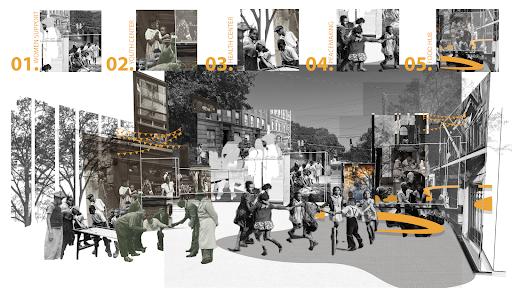

Clusters of Care at various scales.
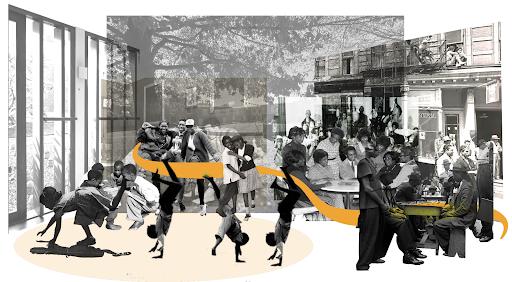
[3]
[1] [2] [3] 121 ATLANTA AFTER PROPERTY VOL. 2


[4] [5] 122 FALL 2022
We aim to address all functions of care by breaking away from the transactional nature supported by the Prison Industrial Complex. Transforming the existing prison on site, we use expansions and new joints as an adaptive re-use strategy to create spaces such as youth and health centers for residents.


Health care for physical and emotional support care center.
Church as a care for spirituality which could not only provide mental health care but also gathering space.
[4] [5]
123 ATLANTA AFTER PROPERTY VOL. 2




In a world after property, we must dismantle our current systems of social, political and spatial construct. In order to create a new social and spatial order, we should first overcome the current systems of property ownership and political borders that restrict us. This can be achieved by redefining boundaries or destroying them altogether in order to create a new aspect of dynamic space.
ATLANTA AFTER GAMES
OLYMPIC STADIUM
Olympic legacy includes the long-term benefits that the Olympic Games create for the host city, its people, and the Olympic Movement before, during and long after the Olympic Games are held.
Atlanta, where the 1996 Olympic games were held, did not share this legacy with local residents. Instead, the government gave way to elitist housing policies and practices that exacerbated existing inequalities. Many local residents, including the ones from public housing, were displaced by Olympic-related demolition and gentrification.

Throughout our research we are asking the question: What is legacy? Is it displacing thousands of people for Olympic related demolition? Or stanching away the employment of many for an event that only lasts for two weeks? Our after property project aims to bring back the
people who once resided in these neighborhoods, and envision giving power to the hands of those compromised communities to redefine legacy.
The current urban planning of Summerhill has been an attempt to concretize regimes of power that demonstrate control and dominance. This planning approach supports most dominant discourse, which assumes that space occupied by low-income and racialized people needs to be tamed, civilized, or redeveloped. In our quest for a world after property, we seek to redefine what is considered valuable by prioritizing intangible forms of wealth over financial gain. Through this project, we aim to invent tactics against the marginalizing logics of capitalism. We are interested in creating a constellation of spaces that practice refusal against private and racialized enclosures.
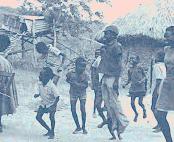 Hyperlocal Network Urban Village
Communal Construction Kalinago Territory
ANKITA SHARMA CHANG YUP SHIN YAN HUO RUBIN LIAN
Hyperlocal Network Urban Village
Communal Construction Kalinago Territory
ANKITA SHARMA CHANG YUP SHIN YAN HUO RUBIN LIAN
126 FALL 2022


[1] FALL 2022 128

ATLANTA AFTER PROPERTY VOL. 2 129


FALL 2022 130 [2]

ATLANTA AFTER PROPERTY VOL. 2 131 [3]

[4] FALL 2022 132
[1] [2] [3] [4]

Expansion of a land trust and the removal of single-family homes for participating residents.
Removing zoning restrictions such as property lines and setback lines.
A new collective housing typology that expands and merges, by dissolving boundaries. This typology morphs into an expandable rooftop structure network and shared courtyards to create a multi-generational relationship.
Local community takes collective ownership of the land. ATLANTA AFTER PROPERTY VOL. 2 133
We define property as the reliance on ownership and the acceptance of systems that segregate and marginalize. We recognize cars as being emblematic of the existing property regime and identified the systematic choke-hold that cars and the policies historically made to accommodate them as drivers of implementing property and creating inequitable urban landscapes.
DE-MARKING
DOWNTOWN PARKING
IZA KHAN
SANAH MENGI
Atlanta and its communities have fallen victim to the city’s decision to prioritize cars, embedding a divide throughout the city. Thus, car routes are controlled and land remains vacant to accommodate the convenience of the few over the lives and relations of the many. Our site, downtown Atlanta, stands as a testimony to the state’s misplaced priorities. We recognize the parking lines as state enforced direction, control and isolation. Our critiques center around these marked methodologies that implement ownership for capital endeavors. These endeavors reserve land temporarily for the car owner, while also hoarding land, as parking lots, for future profit and speculation for land owners.
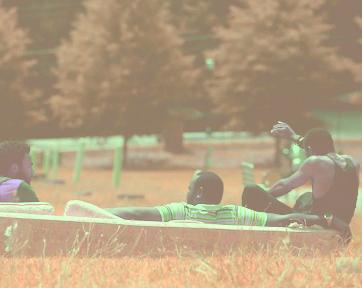
Through this critique, of a carcentered downtown, we begin imagining a world after property. A world that is not subservient to the interests of the individual,
thus we begin to imagine a world without cars. We remove the urban systems that dictate the landscape. We first removed the roads and redefined what we know as the street. Then we manipulated the parking lines that populate the vast landscape. We created strategies for removal and reorientation. How can the lines that have divided us be reimagined to create coherent communal systems that encourage growth. How do we wash away years of directional divide and marginalization?
 Multi-temporal Arcade Qilou, Taiwan
Outdoor Domesticity Atlanta, FX 2016
MARINA GUIMARAES
Multi-temporal Arcade Qilou, Taiwan
Outdoor Domesticity Atlanta, FX 2016
MARINA GUIMARAES
134 FALL 2022



[2] [1] 136 FALL 2022



138 FALL 2022
In our world the lines remain as reminiscent of a world that was on the brink of breaking.
There are no longer vacant lines on asphalt hoarded by the few who can afford them.
They are reoriented and restructured as spaces that accept and accommodate the collective existence.

Replacing cars with domesticity in parking spaces
Representation of the vastness of parking homogenity
Next Page: Paths were built to move into these spaces and we blend the landscape with vegetation that stood in contrast to the previous asphalt as we remind ourselves of the ecologies lost in our struggles for capital.

[1] [2] [3] 139 ATLANTA AFTER PROPERTY VOL. 2



[3]
Activation Nodes Project Structures



Circulation Paths Vegetation
SAMPLES CATALOG
Students work in groups to select critical images and invent analytical drawing techniques that identify, take account, and diagram specific ‘Samples’. For the purposes of this studio, Samples are defined as existing spatial concepts and practices that defy the bounds of property. These samples were then used to redesign one of the sites in the collective catalog, prefiguring a world after property. The samples were selected based on their potential to redress recursive dispossessions.
142 FALL 2022
01 Queering The City 02 Queering Green Infrastructure 03 Mexico-United States Border 04 Jodhpur Brahmapuri 05 Shanty Town 06 Trap Houses 07 Siachen Glacier 08 Remembrance as Resistance 09 Fire Hydrants 10 The Villages in Guangzhou 11 Chawls of Mumbai 12 Manek Chowk 13 Autonomous Organism 14 Multi-Temporal Arcade 15 Ephemeral Ownership 16 Outdoor Domesticity 17 Open Grazing 18 Republic of Rose Island 19 Sonoran Desert Foraging 20 Communal Construction 21 Koliwadas, The Extension Jugaad 22 Hehuatang, Nanjing, China 23 Blurring Edges of Property 24 Courtyard House 25 Practice of Namaz 26 Dharavi 143 ATLANTA AFTER PROPERTY VOL. 2
QUEERING THE CITY
BEHIND THE FACADE
 Heer Shah, Maria G Flores, Tippi Huang, Yaoze Yu
Heer Shah, Maria G Flores, Tippi Huang, Yaoze Yu
144 FALL 2022
After-property serves as a series of occasions, where one tries to covertly rebel against the imposed set of regulations. Capital serves as a mask, subsequently playing by it’s own rules, while presenting to the world what it wants to see.


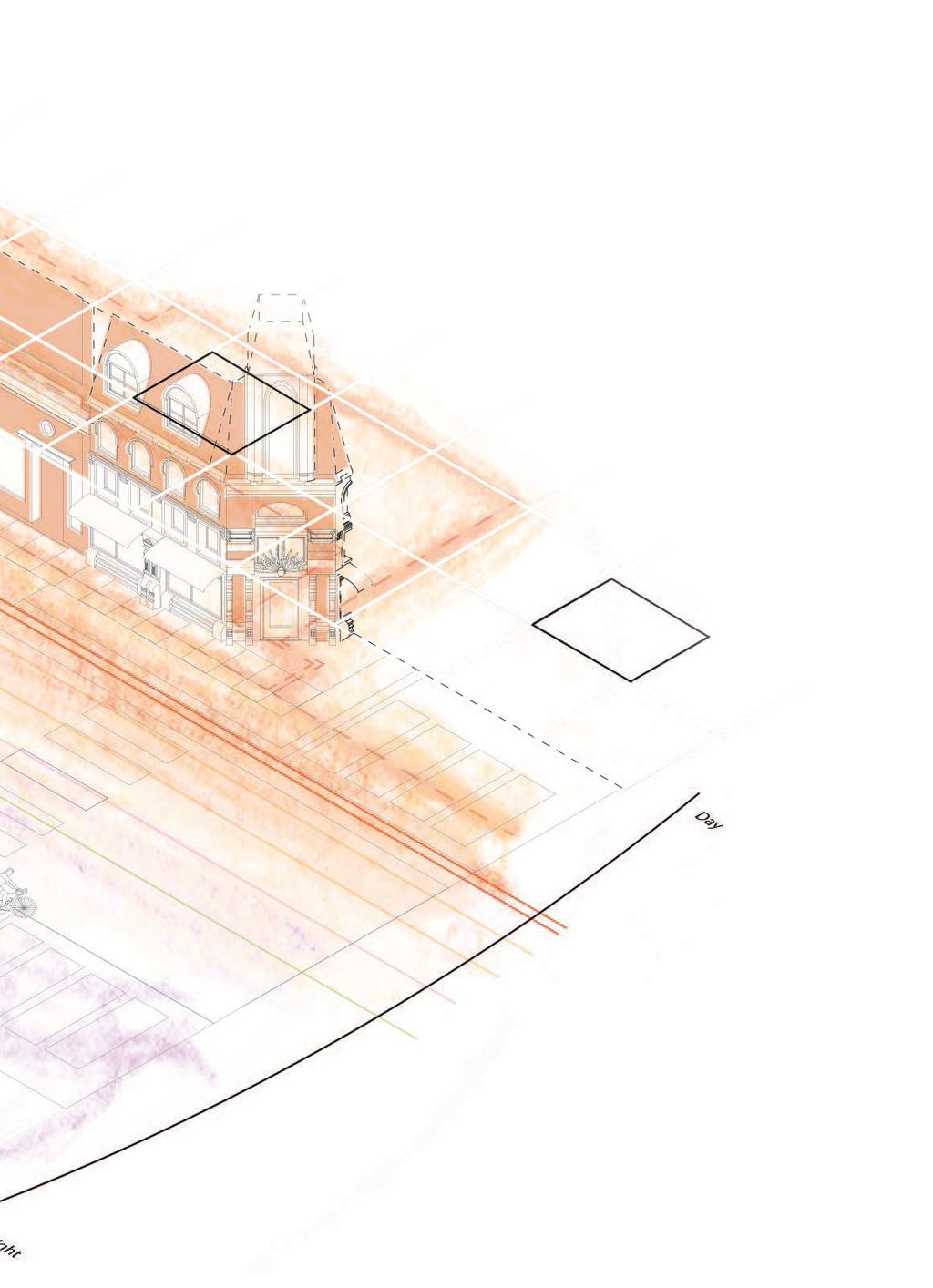 Bakers Bakery, 2020
Bakers Bakery, 2020
SAMPLE 01 145 ATLANTA AFTER PROPERTY VOL. 2
Bakers Bakery, 2016
QUEERING GREEN INFRASTRUCTURE

INTERFACE
GREEN
146 FALL 2022
Heer Shah, Maria G Flores, Tippi Huang, Yaoze Yu
After property is a interface to allow people to be themselves against what property expects.


 Parts and Things, Salman Toor, 2019
Parts and Things, Salman Toor, 2019
SAMPLE 02 147 ATLANTA AFTER PROPERTY VOL. 2
The Queen, Salman Toor, 2020
INTANGIBLE CROSSING

MEXICO-UNITED STATES BORDER

148 FALL 2022
Ruxuan Zheng, Jingyi Liu, Jiani Dai, Chongyang Ren
On the premise that it is impossible to change the spatial division of the Mexico-United States border by established physical boundaries, we suggest one’s “individual identity” be as (respected or considered) as the “group identity.” Through spatial design, we can awaken those intangible cultures and bloodline connections and thus cross the fragmentation brought by spatial politics.


 Luise Torres/AFP/Getty Images, 2019
Rio Grande, Politica Estera, 2014
Luise Torres/AFP/Getty Images, 2019
Rio Grande, Politica Estera, 2014
SAMPLE 03 149 ATLANTA AFTER PROPERTY VOL. 2
JODHPUR BRAHMAPURI
COLOR, SPACE, PHENOMENOLOGY
 Ruxuan Zheng, Jingyi Liu, Jiani Dai, Chongyang Ren
Ruxuan Zheng, Jingyi Liu, Jiani Dai, Chongyang Ren
150 FALL 2022
Defying the binary divide between property ownership and steering towards varying degrees of in between conditions, a middle ground emerges, expanding for greater shared space.


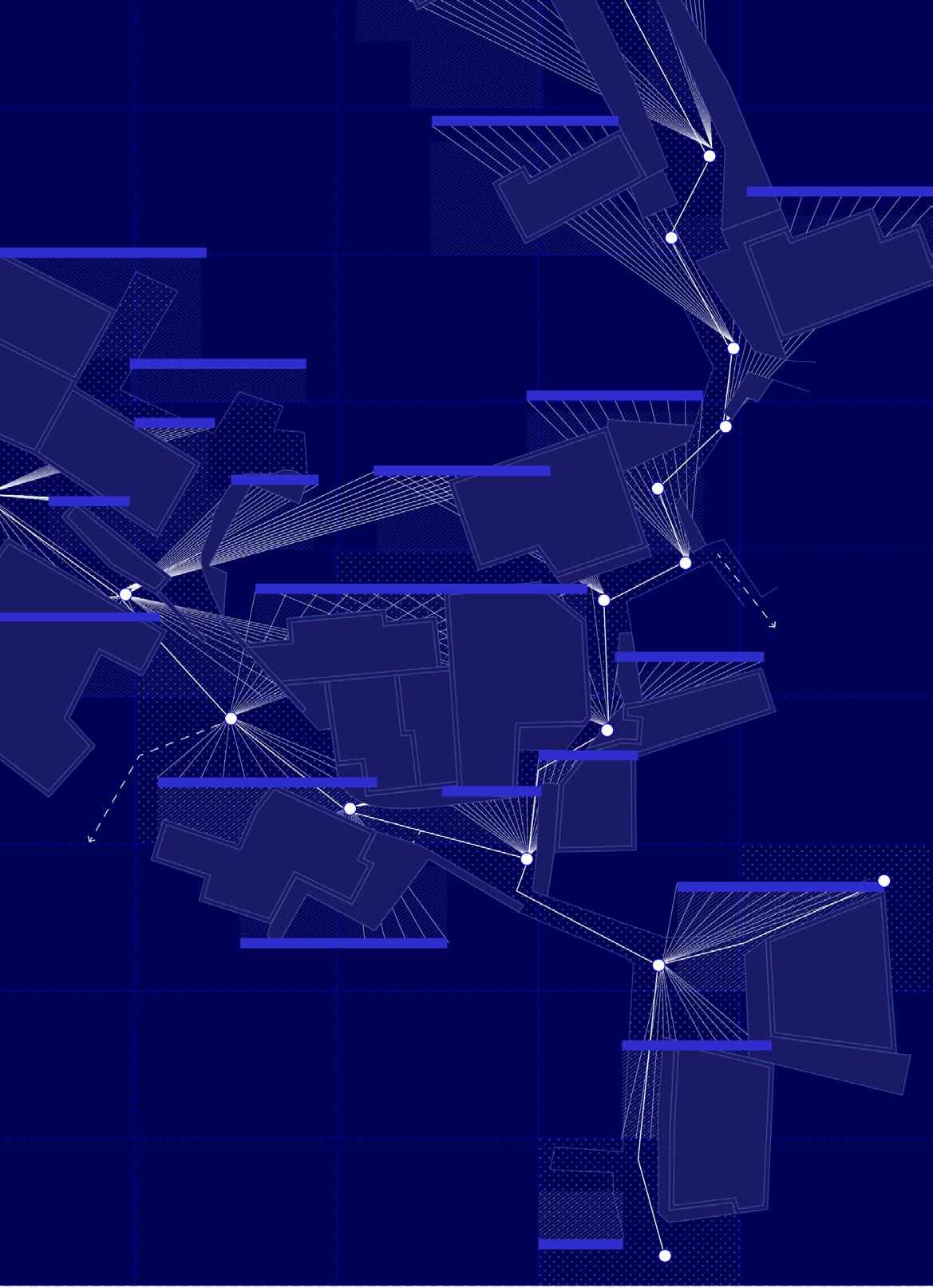
SAMPLE 04
Tuul and Bruno Morandi, Getty Images, 2013
151 ATLANTA AFTER PROPERTY VOL. 2
Nila Newsom, Shutterstock, 2021
SHANTY TOWN
SPACES OF INFORMAL GROWTH
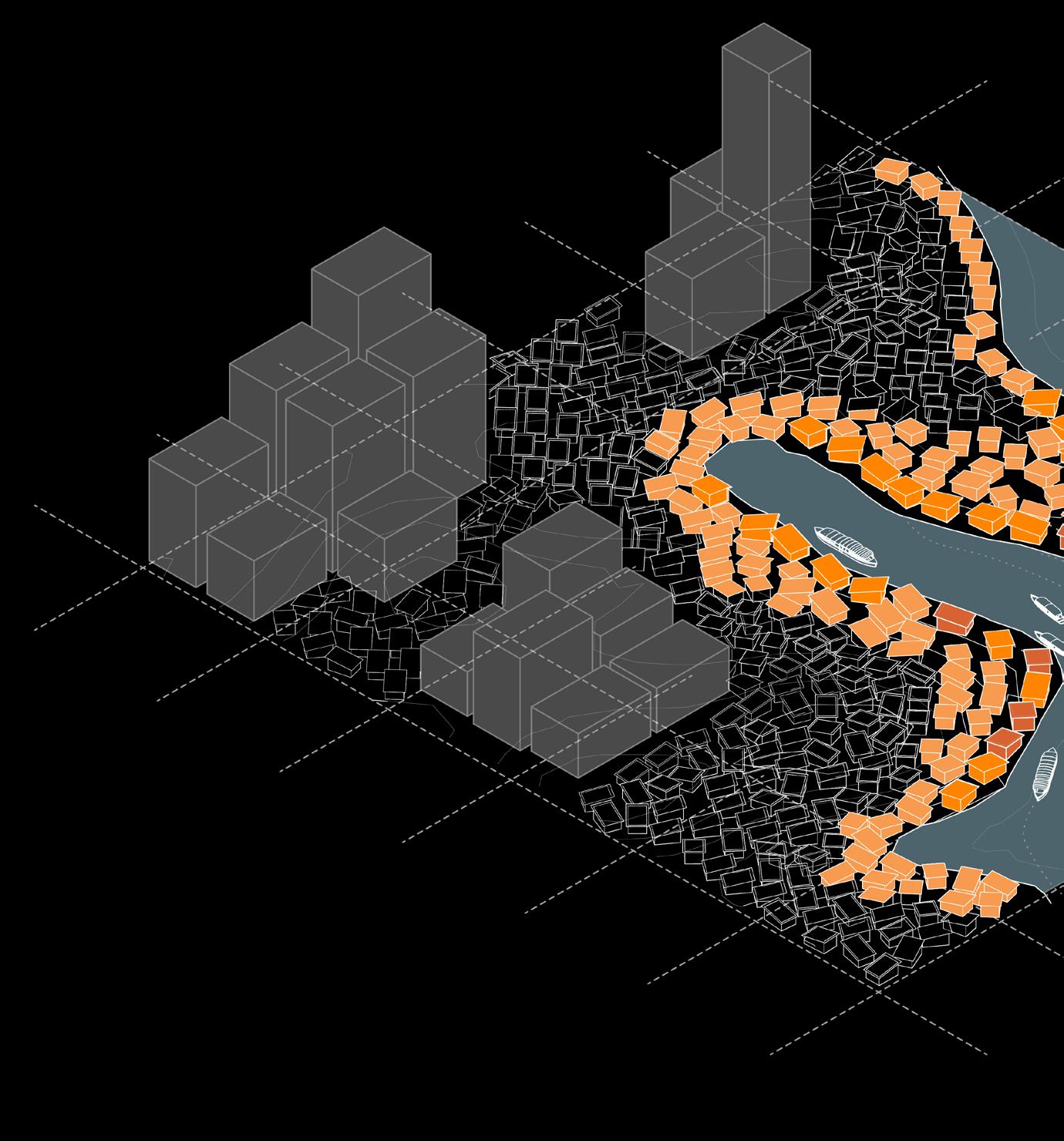
152 FALL 2022
Nupur Shah, Simran Gupta, Aashwita Yadav, Rohin Sikka
Tracing informal growth and transitions that happen in a space, defying patterns of city growth. They define their own life cycle through presence, interaction, and growth. The tensions between this independent system and the existing city is crucial.


 Wu Jianping, 2000
Lalen Rios Luna, 2022
Wu Jianping, 2000
Lalen Rios Luna, 2022
SAMPLE 05 153 ATLANTA AFTER PROPERTY VOL. 2
TRAP HOUSES
SPACES WITHOUT OWNERSHIP

154 FALL 2022
Nupur Shah, Simran Gupta, Aashwita Yadav, Rohin Sikka
Properties abandoned and not owned by anyone, can be used temporarily in any manner deemed right by multiple occupants.


 CreatorLA, 2018
Alexis Montero, 2018
CreatorLA, 2018
Alexis Montero, 2018
SAMPLE 06 155 ATLANTA AFTER PROPERTY VOL. 2
SIACHEN GLACIER
SHIFTING BOUNDARIES

156 FALL 2022
Anagha Arunkumar, Donnal Baijnauth, Haoyu Hu, Xu (Chelsie) Cheng
Koonyongyut/iStock/Getty Images, 2019

Blurring boundaries through shifting landscapes and anthropological intervention.

Without any clearly demarcated boundaries, territorial control is dealt in elevations and identified through the mountain peaks. With the seasonal melting and refreezing of the Siachen Glacier, geopolitical boundaries are continually being renegotiated.
 Ciril Jazbec, 2015
Ciril Jazbec, 2015
SAMPLE 07 157 ATLANTA AFTER PROPERTY VOL. 2
REMEMBRANCE AS RESISTANCE
AFRICAN BURIAL GROUND

158 FALL 2022
Anagha Arunkumar, Donnal Baijnauth, Haoyu Hu, Xu (Chelsie) Cheng
Civic engagement and protest as a powerful tool to spatialize and memorialize historic events of deep significance, from the machinations of real estate speculation and development.


 National Park Service, 2018
National Park Service, 2018
SAMPLE 08 159 ATLANTA AFTER PROPERTY VOL. 2
AP Photo/Mark Lennihan, 2020
FIRE HYDRANTS
BLURRING BOUNDARIES

160 FALL 2022
Devanshi Gajjar, Naumika Hejib, Verena Krappitz, Yashita Khanna
Brooklyn Block Parties, The New York Times, 2019


In a world after property, a transit space triggers creative, non-conforming behavior. Individuals express their own biographies, relationships, ties and interests within blurring boundaries that happen in a stringent, yet ambivalent context.
 Peter Stackpole/Life Magazine, 1953
Peter Stackpole/Life Magazine, 1953
SAMPLE 09 161 ATLANTA AFTER PROPERTY VOL. 2
THE VILLAGES IN GUANGZHOU
HYPER LOCAL SUPPORT NETWORKS

162 FALL 2022
Devanshi Gajjar, Naumika Hejib, Verena Krappitz, Yashita Khanna
NO Studio, 2016
After-property goes beyond the narrative of physical locations. But it is organized through space-specific resources, including social relations and focuses on the individual people-place relationship.
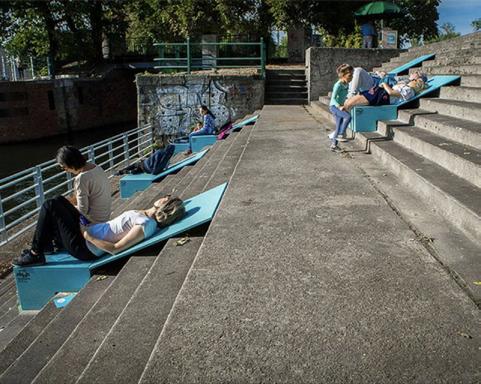

 Our China Story, 2021
Our China Story, 2021
SAMPLE 10 163 ATLANTA AFTER PROPERTY VOL. 2
CHAWLS OF MUMBAI
SOCIO-CULTURAL SPILLOVER

164 FALL 2022
Wenjun Zhu, Hongfeng Wang, Qiannan Guo, Haoyu Zhu
Mumbai’s BDD, 2019

In this poverty-stricken public housing in India, the public and private spaces are blurred, people place their personal belongings in the public space. At the same time, people of different religions and social backgrounds live together and know each other so well that the boundaries between people are also blurred. The expanding chawl system of housing is shifting the existing socio-cultural context within the urban fabric.

 Deepak Joshi, 2021
Deepak Joshi, 2021
SAMPLE 11 165 ATLANTA AFTER PROPERTY VOL. 2
MANEK CHOWK

DYNAMIC
166 FALL 2022
Wenjun Zhu, Hongfeng Wang, Qiannan Guo, Haoyu Zhu
Through mutual understanding and public supervision, people have different ownership rights and supervisory obligations over public space at different times. Under this premise, ownership and the obligation to protect public goods are dynamic, improving community vitality and avoiding crime at different times.


 The Food Dharma, Mehtaworld, 2018
The Food Dharma, Mehtaworld, 2018
The Food Dharma, Mehtaworld, 2018
The Food Dharma, Mehtaworld, 2018
SAMPLE 12 167 ATLANTA AFTER PROPERTY VOL. 2
AUTONOMOUS ORGANISM
THE EXTENDING BOUNDARY

168 FALL 2022
Anchalinad Anuwatnontaket, Mingrui Jiang, Xiutong Yu, Hanfei Fu
Power, social relations, and public interest shape the form of property. Although laws and power regulate the boundary of the property, people redefine and recreate their own space based on their activities and desires, which is strengthened by the bounded relationship between generations.
In this fishing village, defined as an autonomous organism, property is continuously expanding using organic waste that builds over time, becoming new vital land for the public to control.
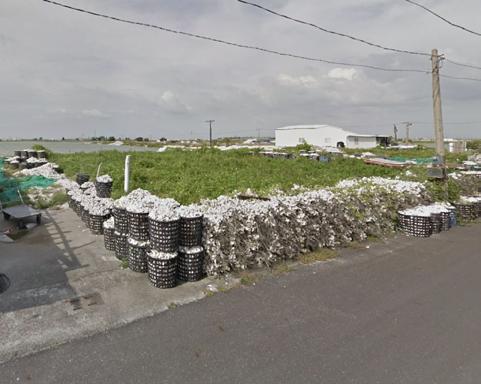

 Luise Torres/AFP/Getty Images, 2019
Rio Grande, Politica Estera, 2014
Luise Torres/AFP/Getty Images, 2019
Rio Grande, Politica Estera, 2014
SAMPLE 13 169 ATLANTA AFTER PROPERTY VOL. 2
MULTI-TEMPORAL ARCADE
TRANSITIONS AND BLURRED BOUNDARIES

170 FALL 2022
Anchalinad Anuwatnontaket, Mingrui Jiang, Xiutong Yu, Hanfei Fu
Property is against nature. It is a discrete, arbitrary and exclusionary system of monetary exchange imposed upon landscape, disregarding the value and logic of continuous surfaces, terrain, aquifer and the cultural and ecological memory of a place.


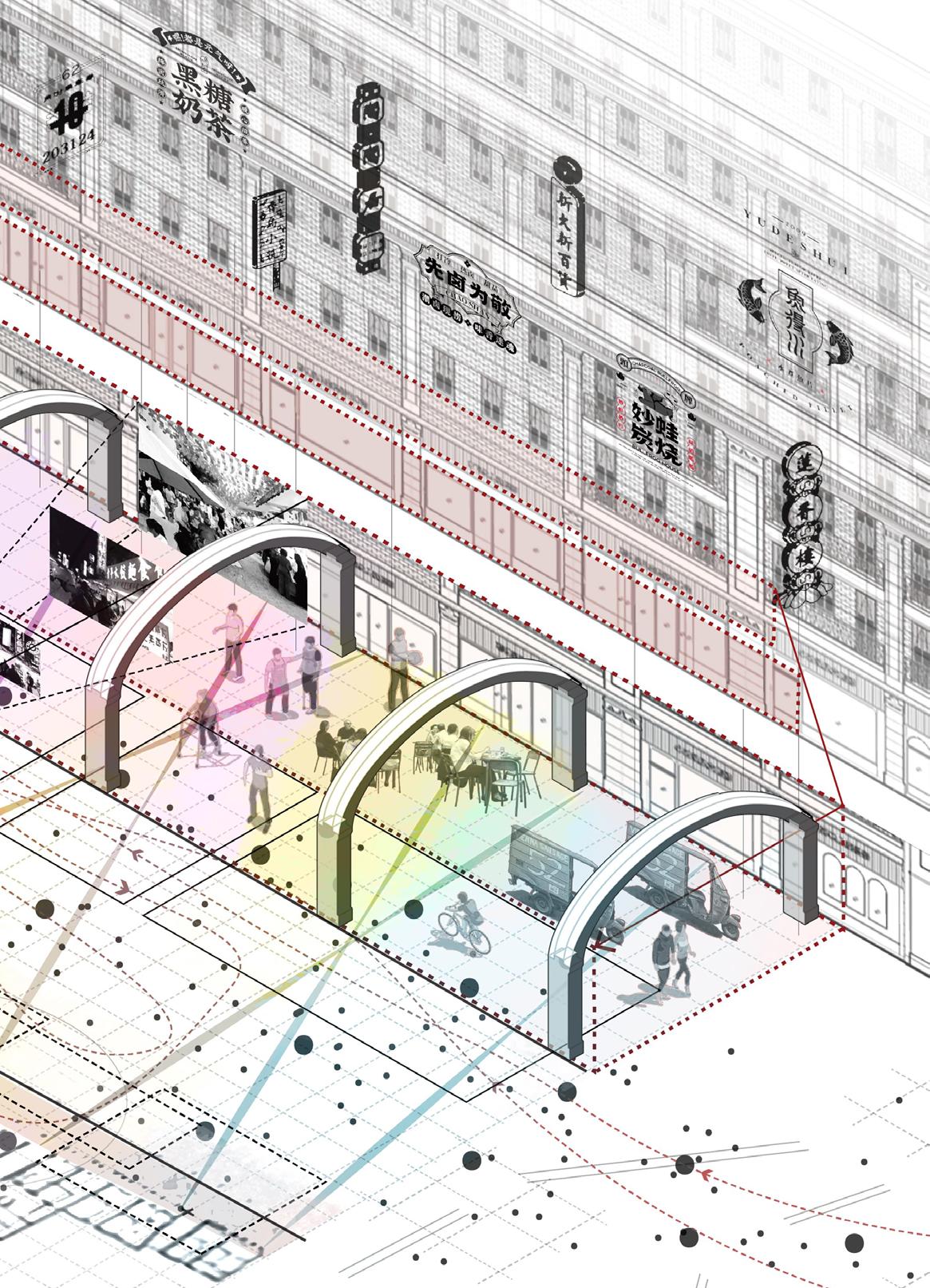 The Guardian, 2017
TakeMeTour, 2020
The Guardian, 2017
TakeMeTour, 2020
SAMPLE 14 171 ATLANTA AFTER PROPERTY VOL. 2
EPHEMERAL OWNERSHIP
WUHAN NIGHT MARKET

172 FALL 2022
Caroline Wineburg, Oreoluwa Adegbola, Vir Shah, Reya Singhi
Bangkok’s Chinatown | The Guardian, 2017
Through expansion and retraction, the night market stalls are in constant flux, negotiating its boundaries through activities and movement within the rigidly defined lines of property.


 Wuhan Night Market, Hanfei Fu and Jianwen Yang, 2020
Wuhan Night Market, Hanfei Fu and Jianwen Yang, 2020
SAMPLE 15 173 ATLANTA AFTER PROPERTY VOL. 2
OUTDOOR DOMESTICITY
 Caroline Wineburg, Oreoluwa Adegbola, Vir Shah, Reya Singhi
Caroline Wineburg, Oreoluwa Adegbola, Vir Shah, Reya Singhi
RECLAMATION 174 FALL 2022
Unraveling Modern Living. Tatiana Bilbao Estudio, 2020

Within the context of the commons, residents recreate the comforts of space through deviation, expansion, and accumulation.

 FX’s Atlanta, 2016
FX’s Atlanta, 2016
SAMPLE 16
175 ATLANTA AFTER PROPERTY VOL. 2
OPEN GRAZING
FLUCTUATING NEGOTIATIONS

176 FALL 2022
John Grunewald, Di Le, Jade Durand, Deepa Gopalakrishnan
Multiple actors with varying circumstances play a role in causing property lines to shift and land divisions to fluctuate. These non-static boundaries of ownership, both human and non-human, are inspected and negotiated.


 Getty Images, 2019
C. de Bode/CGIAR, 2018
Getty Images, 2019
C. de Bode/CGIAR, 2018
SAMPLE 17 177 ATLANTA AFTER PROPERTY VOL. 2
REPUBLIC OF ROSE ISLAND

OF AUTONOMY
SPACE
178 FALL 2022
John Grunewald, Di Le, Jade Durand, Deepa Gopalakrishnan
Wikimedia, 1968


Outside of territorial jurisdiction, exclusive economic waters, a space is made for resisting demands of governmental ownership of person. Absent is the regime of property in the absolute autonomy of self, universal ability to communicate, a reclaiming of sovereignty from a nations control.
 Rose Island (Isola delle Rose), 1968
Rose Island (Isola delle Rose), 1968
SAMPLE 18 179 ATLANTA AFTER PROPERTY VOL. 2
SONORAN DESERT FORAGING
FORAGING AND NON-EXTRACTIVE AGRICULTURE

180 FALL 2022
Rutwik Karra, Yue Huang, Devanshi Pandya, Siwei Tang
CNG Farming, 2017
Foraging is a practice of defying the extraction of land and nature for one’s benefit, and instead creating a balance in ecology by strategically limiting the utilization of land’s natural resources to foster growth and rehabilitation. Sharing of resources, information and networks to create a protective harmonious and stable environment.


 Michael Chiago, 2013
Michael Chiago, 2013
SAMPLE 19 181 ATLANTA AFTER PROPERTY VOL. 2
COMMUNAL CONSTRUCTION
KALINAGO TERRITORY

182 FALL 2022
Rutwik Karra, Yue Huang, Devanshi Pandya, Siwei Tang
Journal de la Societe des Americanistes, 2016
Ceremony, W.H. Brett, 1868


The Kalinago Territory has a collective community and construction methods that encourage boundaryless interactions of daily routines. In a community with a strong social identity, such as that of the Kalinago Territory, the huts are open to each other and inviting.

SAMPLE 20
183 ATLANTA AFTER PROPERTY VOL. 2
KOLIWADAS, THE EXTENSION JUGAAD
OUTDOOR LIVING ROOMS

184 FALL 2022
Sanya Verma, Zicong Liu, Saloni Shah, Yiwan Zhao
The illegal extension of the home onto the sidewalk, using temporary building materials, to extend beyond property lines challenges the rigid edges of property, both physically and spatially. The spillage of their domestic, social activities into the outdoor living room.


 Adam Cohn, 2018
Heritage Chronicles, 2020
Adam Cohn, 2018
Heritage Chronicles, 2020
SAMPLE 21 185 ATLANTA AFTER PROPERTY VOL. 2
HEHUATANG, NANJING, CHINA
EXTENSION AND EXCHANGE OF THE EDGES

186 FALL 2022
Sanya Verma, Zicong Liu, Saloni Shah, Yiwan Zhao
Occupants lives and activities have reshaped the edges of property, by way of extension and exchange. They define the street as collective property.


 Zhuanlan Zhihu, 2019
Zhuanlan Zhihu, 2019
Zhuanlan Zhihu, 2019
Zhuanlan Zhihu, 2019
SAMPLE 22 187 ATLANTA AFTER PROPERTY VOL. 2
BLURRING EDGES OF PROPERTY
ROOF TOPS IN NEW DELHI

188 FALL 2022
Rubin Lian, Yan Huo, Changyup Shin, Ankita Harish Sharma
The edges of property which are based on socio-economic and spatial conditions can provide different realities in the cityscape. These edges can also be shared, exchanged, or borrowed. This opportunity for negotiation can either result in tension or co-existence for the user. By removing their own physical barriers, one can extend their property and retrieve the lost public space.


 Sarah Gunawan, 2015
Vijay Shah, 2012
Sarah Gunawan, 2015
Vijay Shah, 2012
SAMPLE 23 189 ATLANTA AFTER PROPERTY VOL. 2
COURTYARD HOUSE
BEIJING, CHINA

190 FALL 2022
Rubin Lian, Yan Huo, Changyup Shin, Ankita Harish Sharma
Baidu 2019
The courtyard house in Beijing used to be occupied by a single-family, and the courtyard within it’s bounds was therefor privately owned. However, as new owners began to occupy the courtyard, adding additional buildings and their belongings, the spatial boundary between private and public began to transform, leaving much room for negotiation.


 Beijing Walking. Leo Kui, 2020
Beijing Walking. Leo Kui, 2020
SAMPLE 24 191 ATLANTA AFTER PROPERTY VOL. 2
PRACTICE OF NAMAZ
SACRED RITUALS AS SPATIAL PRACTICES

192 FALL 2022
Iza Khan, Sanah Mengi, Marina Guimaraes
Carlo Allegri/Reuters, 2017
Pixwox.@realmuslim_life, 2020


Sacred ritual as a spatial practice that cannot be confined in space nor impacted by societal limitations that are placed upon the body. This practice revolves around how people re-orient themselves in relation to time, aligning with a collective purpose.

SAMPLE 25 193 ATLANTA AFTER PROPERTY VOL. 2
DHARAVI
OUTDOOR LIVING ROOMS

194 FALL 2022
Iza Khan, Sanah Mengi, Marina Guimaraes
Communities are built by association and social interactions. These spaces of commune are formulated through voids, movement, porosity and alliance that is not limited to the physical realm.


 Shalu Khandelwal | Culture Trip, 2017
Flickr. Gynna Millan, 2013
Shalu Khandelwal | Culture Trip, 2017
Flickr. Gynna Millan, 2013
SAMPLE 26 195 ATLANTA AFTER PROPERTY VOL. 2
GUEST LECTURERS
Lecture and Discussion with:
Keller Easterling
Architect, Writer, and Professor at Yale

Keller Easterling is a designer, writer and the Enid Storm Dwyer Professor of Architecture at Yale. Her books include, Medium Design (Verso 2021), Extrastatecraft: The Power of Infrastructure Space (Verso, 2014), Subtraction (Sternberg, 2014), Enduring Innocence: Global Architecture and its Political Masquerades (MIT, 2005) and Organization Space: Landscapes, Highways and Houses in America (MIT, 1999).
Easterling is also the co-author (with Richard Prelinger) of Call it Home, a laserdisc/DVD history of US suburbia from 1934-1960. Easterling lectures and exhibits internationally. Her research and writing was included in the 2014 and 2018 Venice Biennales. Easterling is a 2019 United States Artist in Architecture and Design.

Episode 01
Elora Lee Raymond is an urban planner and Assistant Professor in the School of City and Regional Planning in the College of Design at Georgia Tech. She is interested in the financialization of housing and property in land, displacement and dispossession through housing systems, housing justice, race, segregation, and the transnational Pacific Islander community.
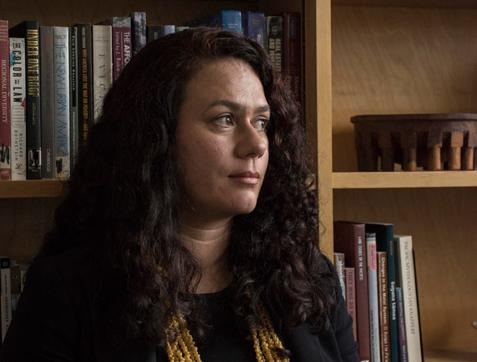
Dr. Raymond has ongoing projects on housing, displacement and disasters, including work on eviction and migration following disasters.
Episode 02
The Guild
Atlanta-based Organization
The Guild is an Atlanta-based organization focused on re-imagining real estate development to build community wealth and resilience. In 2015, they started out by being Atlanta’s first co-living company, creating spaces for change-makers — entrepreneurs, artists, and community organizers — to live, work, gather and thrive. They facilitate workshops and training that cover everything from advanced business basics, to personal finance coaching, and even things like mindful meditation, to provide holistic support to these change-makers who work to positively impact their communities.
They have recently evolved and grown, addressing displacement due to gentrification across metro-Atlanta neighborhoods. They believe the city is grappling with both residential and commercial gentrification, with legacy residents and businesses both at the front line of displacement. This kind of development only serves to widen the already existing racial wealth gap. Instead, they have taken a community-centered approach to development with current projects focused on creating a pathway for community ownership.
Episode 02
Keller Easterling
Elora Lee Raymond
Antariksh Tandon
Elora Lee Raymond
Urban Planner and Assistant Professor at Georgia Tech
196 FALL 2022
Jenny Dubnau

Western Queens CLT Non-Profit Organization
Speakers: The Western Queens Community Land Trust Co-Chair Jenny Dubnau, and panelists Memo Salzar (Co-Chair).
The Western Queens Community Land Trust (WQCLT) is a non-profit organization made up of activists, small business owners, professors, artists, students, and community members who fight for democratic and equitable land use in Western Queens.
“Our communities in Western Queens have been devastated by rampant and encroaching gentrification, which has devastated communities and threatened to turn the neighborhoods we call ‘home’ into playgrounds for the wealthy.”
Episode 02
Mohamad Ziad Jamaleddine
Assistant Professor at Columbia Univeristy and Partner of L.E.FT Architects
Ziad Jamaleddine is Assistant Professor at Columbia GSAPP and co-founder and partner of L.E.FT Architects based in Brooklyn and Beirut. He has been teaching Advanced Architecture and Urban Design Studios, seminars in the History & Theory sequence, and summer workshops at GSAPP since 2014. He also taught at Cornell, PennDesign, Yale School of Architecture, the University of Toronto, and the MIT Aga Khan program.
Ziad Jamaleddine is a practitioner and scholar with a particular research focus on architecture in the Middle East—rigorously interrogating topics such as religious architecture and religiosity in public space, urbanism and infrastructure in relation to water resources and scarcity, and the question of reconstruction in post-war cities.

Episode 03
Dr. Carla Shedd is Associate Professor of Sociology at Georgetown University whose research and teaching focuses on: education; criminalization and criminal justice; race and ethnicity; law; social inequality; and urban policy. Shedd’s first book, Unequal City: Race, Schools, and Perceptions of Injustice (October 2015, Russell Sage), examines Chicago public school students’ perceptions of injustice and contact with police within and across various schools and neighborhoods, and deeply probes the intersections of race, place, education, and the expansion of the American carceral state.

Shedd’s second book project, When Protection and Punishment Collide: America’s Juvenile Court System and the Carceral Continuum, draws on her one-of-a-kind empirical data to interrogate the deftly intertwined contexts of NYC schools, neighborhoods, and juvenile justice courts, in this dynamic moment of NYC public policy shifts.
Episode 03
Ziad Jamaleddine
Dr. Carla Shedd
Associate Professor of Sociology at Georgetown University
197 ATLANTA AFTER PROPERTY VOL. 2
Dr. Carla Shedd
GUEST LECTURERS
Lecture and Discussion with:
Mira Henry is a designer and educator. She is the co-principal of the collaborative architectural design practice Current Interests and is design faculty at SCI-Arc.

Henry’s built work is grounded in notions of material specificity, color relationships, assembly details, and an engagement in critical cultural thinking. Her formal research and writing focus on architecture, race, and materiality. She is the recipient of the 2019 Architectural League Prize, Henry Adams AIA Award, and Archiprix International Gold Medal. She has participated in numerous symposia, lectures, exhibitions, and reviews at institutions nationwide, including Harvard, Yale, and Princeton Universities. Mira holds a Bachelor in Art History from the University of Chicago and a Master of Architecture from UCLA.
Assistant Professor in Practice, Architecture
Gabriel Cuéllar is an assistant professor-in-practice at the University of Minnesota School of Architecture. His work focuses on urban formations, territorial and preservation practices, and the role of architectural knowledge in struggles for spatial justice.

Together with Athar Mufreh, Gabriel directs Cadaster, a practice concerned with territory and architectural design and inquiry. Cadaster was awarded The Architectural League Prize in 2018. His writings have appeared in publications by Sternberg Press and Routledge. The work of Gabriel and his collaborators has been exhibited in the Canadian Centre for Architecture, the Netherlands Architecture Institute, the House of World Cultures, The New School Parsons School of Design, and the University of Michigan. In 2020, Gabriel received an award from Columbia GSAPP’s Buell Center for his pedagogy on Architecture, Climate Change, and Society. Gabriel is a registered architect and a member of NOMA, The Architecture Lobby, and AIA.
Kamal engages CGI storytelling as a way of exploring relationships between culture, space, and ecology. In 2017 he received a Masters in Landscape Architecture from Harvard GSD and a Master of Arts in SCI-Arc’s postgraduate Fiction and Entertainment program in 2019.
His work continues to use themes of landscape and fiction as a way of envisioning speculative environments. Through fiction, Kamal is interested in depicting relationships between cultural abstractions and geological phenomena. His focus on landscape-centric narratives is the driving force behind the worlds he brings to life through animation, game engine technology, music, and storytelling. Kamal’s work offers another perspective on the way we think about space and the cultural behaviors that shape it.
 Mira Henry Co-Principal of Current Interests and Faculty at SCI-Arc.
Episode 03
Mira Henry
Jeremy Kamal Landscape Architect, Visual Artist, and faculty at SCI-Arc.
Episode 04
Jeremy Kamal
Gabriel Cuellar
Gabriel Cuellar
Mira Henry Co-Principal of Current Interests and Faculty at SCI-Arc.
Episode 03
Mira Henry
Jeremy Kamal Landscape Architect, Visual Artist, and faculty at SCI-Arc.
Episode 04
Jeremy Kamal
Gabriel Cuellar
Gabriel Cuellar
FALL 2022 198
Episode 04 and Reading 02
ACKNOWLEDGMENTS
Adam Lubinsky
WXY, Columbia GSAPP
Akira Drake Rodriguez
University of Pennsylvania’s School of Design
Andres Jaque
Dean, Columbia GSAPP
Antariksh Tandon
The Guild, Atlanta
Ateya Khorakiwala
Columbia GSAPP, Harvard GSD
Avani Agarwal
GSAPP, MSAUD 22’ Alumni
Bryony Roberts
Bryony Roberts Studio, Columbia GSAPP
Caleb Negash
Black in Design
Cesar Delgado
GSAPP, MSAUD 22’ Alumni
Daniel D’Oca
Interboro, Harvard GSD
David Shane
Columbia GSAPP
Devin Morris
Brooklyn based artist, Nii Journal (London)
Dilip Da Cuna
Harvard GSD, Columbia GSAPP
Eric Bunge
nARCHITECTS, Columbia GSAPP
Govardan Umashankar
GSAPP, MSAUD 22’ Alumni
Ife Vanable
Yale Architecture, Cornell AAP
Jacob Moore
Columbia GSAPP
James Graham California College of the Arts
Jerome Haferd, Brandt Haferd, CCNY
Jordan H. Carver Columbia GSAPP
Kaja Kühl
YOUARETHECITY, Columbia GSAPP
Laura González Fierro
Studio Fierro, Columbia GSAPP
Lexi Tsien Soft-Firm, Columbia GSAPP
Lindsey Wikstrom Mattaforma, Columbia GSAPP
Lucas Cohello Netto GSAPP, MSAUD 22’ Alumni
Mabel Wilson Studio&, Columbia GSAPP
Malcolm Rio
RISD Architecture, Columbia GSAPP
Mario Gooden
MARIOGOODENSTUDIO, Columbia GSAPP
Najha Zigbi-Johnson
The Shabazz Center
Nicholas McDermott
Future-Expansion, Yale Architecture
Nupur Roy Chaudhury
ONE Architecture and Urbanism
Oscar Oliver-Didier
Fordham University, Columbia GSAPP
Patti Anahory
Columbia GSAPP
Peter Robinson
WorkUrban, Cornell University
Quilian Riano
Pratt School of Architecture
Reinhold Martin
Urban Patch, Columbia GSAPP
Xiaoxi Chen
XIAOXI, Columbia GSAPP
Yasmine Katkhuda
GSAPP, MSAUD 22’ Alumni
Ziad Jamaleddine
L.E.FT Architects, Columbia GSAPP
199 ATLANTA AFTER PROPERTY VOL. 2
We thank you for your time, engagement, questions, and conversation in our collective pursuit of a world after property.
EPILOGUE
The Fall 2022 edition of the Atlanta After Property Studio is an intrinsic part of an ongoing conversation on a world beyond notions of property as we know it today. What would it look like, and how will we get there?
The aim of this studio was to design a region, with hopes of building a world, that is predicated on collective stewardship and care. Through radical reinterpretations of historical and contemporary interventions where the everyday struggle begins to approach the surreal, or even sublime, we aimed to liberate urban design from its historical commitment to borderization.
Through our explorations, we celebrated undervalued and overlooked spatial practices that actively dismantle the Cartesian frame of racial capitalism, and committed ourselves to imaging a different world.
Atlanta After Property continues to reframe the discipline of urban design and reimagine the city of Atlanta in solidarity with contemporary movements of Black liberation, anti-coloniality, and mutuality; working against the ruthless policing, dispossession, and displacement of marginalized communities.

In reflecting on studio provocations, projects and trajectories, we meditated on a series of questions to augment our collective learnings and further the conversation on a world after after property.
How can we unlink remediation from removal?
Remediation is almost always framed as well-intentioned relief, but has the opposite effect when true stakeholders are bereft of care and consideration. Atlanta’s rebranding as a sports destination is one among many examples of how the rights and interests of marginalized populations were sacrificed in the name of urban redevelopment and renewal.
Far too often, designer-developers in the throes of a savior complex deem removal vital to remediation. This approach fails to recognize the value of existing socio-cultural and spatial fabrics. When value beyond capital is recognized, we see that removal can be a reckless and dangerous proposition.
Transcending removal is not an automatic guarantor of the endeavor’s success, but it is crucial in ensuring that the welfare of communities is not neglected in decision-making processes. More inclusive models of decision-making allow for a diverse set of voices to be heard, reparations to be made, and develop networks of care that enable people to experience collective success. Unlearning the attraction towards a ‘tabula rasa’ allows us
to also transcend conventional purpose, and imbue greater meaning to existing spaces and spatial practices. Remediation then becomes more about cherishing and building upon existing communal wealth.
Reparations are a key element of the redefined ‘remediation’ - this can be achieved in multiple forms and actions. Acknowledgment of past and ongoing injustices is the critical first step to healing, which then continues with active steps to remember, restore, reclaim and reinstate.
Remediation and reparation are thus irrevocably linked to a fundamental shift from anonymous to intimate, indirect participation to direct agency, and embracing collective care as a personal and societal constant.

FALL 2022 200
How can we design beyond the tyranny of permanence?

Over the centuries, colonial land practices have left deep scars upon the earth’s inhabited surface. The manner in which land continues to be parcelled and exploited for ownership and production hampers its natural abilities.
This legacy is seen in the swathes of urban areas that have become emblematic of the regime and display contentious relationships between architecture and geopolitics, involving the discipline’s intertwined role in the capital economy, and in cultural production.
Is liberation achieved before, during, or after property?
Liberation can be viewed and defined in a multitude of ways. It is, above all, a way of being that is ungovernable. It is omnipresent despite perpetual oppression by private capital and ownership. The regime of property has failed to expunge collective resistance, joy, care, shared knowledge, and kinship. It is embedded in the very concept of home, at our tables of shared meals and woven through temporal and spatial connection.
Property imprisons through the arbitrary and materialistic valuation of objects, people and experiences. Liberation from this phenomenon is achieved only in a world beyond property, where value is inherent and inviolable.
In the process of achieving liberation, urban and social systems defy and transcend convention, making these systems an indivisible part of each individual’s life. This must be reflected in all aspects of what make human life meaningfulphysical, mental, emotional, cultural and spiritual enrichment.
Liberation calls for the decentralization
and deinstitutionalization of systems of education, healthcare, employment and more. It simultaneously creates, and is achieved by, mutual trust and equitable partnerships beyond spatial and temporal boundaries. This is achieved through bold, collective actions that question the legitimacy of existing systems of value that thrive on exclusion and discomfort. Liberation is rooted in a social value system that puts human need above all, and encourages people to take what they need without hesitation and share what they can freely and joyfully. We revalue human systems by devaluing the forces of capital.
The achievement of liberation from the current production paradigm is also a continuous and ongoing process. In liberation, pre-colonial Indigenous cosmologies inspire how we redefine the relationship between humans and the non-human world based on kinship and collective care.
In this new paradigm, human and non-human lives are intertwined - a technological reinterpretation renders nature inseparable from culture. Thus, technological tools are co-opted in the quest to achieve social, spatial and environmental liberation.
By rejecting fleeting trends and embracing a multi-temporal understanding of spatial relations, we create enclaves that resist privatized enclosure. We must reimagine our role as one of engendering connections, rather than dictating their nature.
Understanding the earth’s autonomy is the first step in exposing this temporality, uncertainty and complexity of the spaces we inhabit and steward. Designed spaces should not carve out borders of time and space. Instead, a co-constitutive relationship between communities and natural elements can allow people to flourish in collective ways of living.
The tyranny of perpetual ownership, of social obligations created by an industrial complex, of design permanence are all linked to the present deep-rooted system, so much so, that to change is to demand a radical ethical shift.
What is needed is neither remediation nor removal, but a global social manifesto that embraces the quotidian and the spectacular equanimously, one that values the being more than the object and appreciates the impermanence of life itself.
201 ATLANTA AFTER PROPERTY VOL. 2
ATLANTA AFTER PROPERTY vol. 2
FALL 2022
URBAN DESIGN STUDIO II
COLUMBIA GSAPP
A6820-1
INSTRUCTORS:
EMANUEL ADMASSU
NINA COOKE JOHN
CHAT TRAVIESO
JELISA BLUMBERG
REGINA TENG
A.L. HU
GALINA NOVIKOVA







 – Grace Kyungwon Hong
– Grace Kyungwon Hong








 Mabel O. Wilson, “Mine Not Yours.”
Harwell Hamilton Harris, Weston Havens House, Berkeley, 1940. Photo: Maynard L. Parker. The Huntington Library, San Marino, California.
Zadie Smith, “Toyin Ojih Odutola’s Visions of Power”
Mabel O. Wilson, “Mine Not Yours.”
Harwell Hamilton Harris, Weston Havens House, Berkeley, 1940. Photo: Maynard L. Parker. The Huntington Library, San Marino, California.
Zadie Smith, “Toyin Ojih Odutola’s Visions of Power”


 HIGH MUSEUM
CIVIL BIKES
PONCE ST. MARKET
DOWNTOWN
PANEL DISCUSSION
KROG ST TUNNEL
SW ATLANTA
HILTON HOTEL
HIGH MUSEUM
CIVIL BIKES
PONCE ST. MARKET
DOWNTOWN
PANEL DISCUSSION
KROG ST TUNNEL
SW ATLANTA
HILTON HOTEL















 Lauren Tate Baeza Fred and Rita Richman Curator High Museum
Lauren Tate Baeza Fred and Rita Richman Curator High Museum



































 Behind the Facade Queering of the City
Non-extraction Sonoran Desert Foraging
HEER SHAH
HUANG
Behind the Facade Queering of the City
Non-extraction Sonoran Desert Foraging
HEER SHAH
HUANG









































 Intangible Crossing Mexico-US Border
Outdoor Living Rooms Dharavi
ANAGHA ARUNKUMAR
Intangible Crossing Mexico-US Border
Outdoor Living Rooms Dharavi
ANAGHA ARUNKUMAR























 NAUMIKA HEJIB
DEVANSHI GAJJAR
Open Grazing in Ado Awaye White Oak Pastures Farm Stay USA, 2022
NAUMIKA HEJIB
DEVANSHI GAJJAR
Open Grazing in Ado Awaye White Oak Pastures Farm Stay USA, 2022
































 Koliwadas The Extension of Jugaad
Candle Vigils Remembrance as Resistance
Koliwadas The Extension of Jugaad
Candle Vigils Remembrance as Resistance




 [3] Rediscovery of the underground and on-ground memories.
[1] A dilapidated brick wall on site.
[3] Rediscovery of the underground and on-ground memories.
[1] A dilapidated brick wall on site.





















 DEEPA GOPALAKRISHNAN DI LÊ JADE DURAND JOHN GRUNEWALD
Trap House Vicent Desailly
DEEPA GOPALAKRISHNAN DI LÊ JADE DURAND JOHN GRUNEWALD
Trap House Vicent Desailly



















 [4] [5] [6]
[4] [5] [6]



 Incremental Housing Traditional Courtyard Houses, Beijing
Co-care Network Chawl Houses, Mumbai
SALONI SHAH
VERMA
Incremental Housing Traditional Courtyard Houses, Beijing
Co-care Network Chawl Houses, Mumbai
SALONI SHAH
VERMA















 Hyperlocal Network Urban Village
Communal Construction Kalinago Territory
ANKITA SHARMA CHANG YUP SHIN YAN HUO RUBIN LIAN
Hyperlocal Network Urban Village
Communal Construction Kalinago Territory
ANKITA SHARMA CHANG YUP SHIN YAN HUO RUBIN LIAN









 Multi-temporal Arcade Qilou, Taiwan
Outdoor Domesticity Atlanta, FX 2016
MARINA GUIMARAES
Multi-temporal Arcade Qilou, Taiwan
Outdoor Domesticity Atlanta, FX 2016
MARINA GUIMARAES














 Heer Shah, Maria G Flores, Tippi Huang, Yaoze Yu
Heer Shah, Maria G Flores, Tippi Huang, Yaoze Yu


 Bakers Bakery, 2020
Bakers Bakery, 2020



 Parts and Things, Salman Toor, 2019
Parts and Things, Salman Toor, 2019




 Luise Torres/AFP/Getty Images, 2019
Rio Grande, Politica Estera, 2014
Luise Torres/AFP/Getty Images, 2019
Rio Grande, Politica Estera, 2014
 Ruxuan Zheng, Jingyi Liu, Jiani Dai, Chongyang Ren
Ruxuan Zheng, Jingyi Liu, Jiani Dai, Chongyang Ren






 Wu Jianping, 2000
Lalen Rios Luna, 2022
Wu Jianping, 2000
Lalen Rios Luna, 2022



 CreatorLA, 2018
Alexis Montero, 2018
CreatorLA, 2018
Alexis Montero, 2018



 Ciril Jazbec, 2015
Ciril Jazbec, 2015



 National Park Service, 2018
National Park Service, 2018



 Peter Stackpole/Life Magazine, 1953
Peter Stackpole/Life Magazine, 1953



 Our China Story, 2021
Our China Story, 2021



 Deepak Joshi, 2021
Deepak Joshi, 2021



 The Food Dharma, Mehtaworld, 2018
The Food Dharma, Mehtaworld, 2018
The Food Dharma, Mehtaworld, 2018
The Food Dharma, Mehtaworld, 2018



 Luise Torres/AFP/Getty Images, 2019
Rio Grande, Politica Estera, 2014
Luise Torres/AFP/Getty Images, 2019
Rio Grande, Politica Estera, 2014



 The Guardian, 2017
TakeMeTour, 2020
The Guardian, 2017
TakeMeTour, 2020



 Wuhan Night Market, Hanfei Fu and Jianwen Yang, 2020
Wuhan Night Market, Hanfei Fu and Jianwen Yang, 2020
 Caroline Wineburg, Oreoluwa Adegbola, Vir Shah, Reya Singhi
Caroline Wineburg, Oreoluwa Adegbola, Vir Shah, Reya Singhi


 FX’s Atlanta, 2016
FX’s Atlanta, 2016



 Getty Images, 2019
C. de Bode/CGIAR, 2018
Getty Images, 2019
C. de Bode/CGIAR, 2018



 Rose Island (Isola delle Rose), 1968
Rose Island (Isola delle Rose), 1968



 Michael Chiago, 2013
Michael Chiago, 2013







 Adam Cohn, 2018
Heritage Chronicles, 2020
Adam Cohn, 2018
Heritage Chronicles, 2020



 Zhuanlan Zhihu, 2019
Zhuanlan Zhihu, 2019
Zhuanlan Zhihu, 2019
Zhuanlan Zhihu, 2019



 Sarah Gunawan, 2015
Vijay Shah, 2012
Sarah Gunawan, 2015
Vijay Shah, 2012



 Beijing Walking. Leo Kui, 2020
Beijing Walking. Leo Kui, 2020







 Shalu Khandelwal | Culture Trip, 2017
Flickr. Gynna Millan, 2013
Shalu Khandelwal | Culture Trip, 2017
Flickr. Gynna Millan, 2013








 Mira Henry Co-Principal of Current Interests and Faculty at SCI-Arc.
Episode 03
Mira Henry
Jeremy Kamal Landscape Architect, Visual Artist, and faculty at SCI-Arc.
Episode 04
Jeremy Kamal
Gabriel Cuellar
Gabriel Cuellar
Mira Henry Co-Principal of Current Interests and Faculty at SCI-Arc.
Episode 03
Mira Henry
Jeremy Kamal Landscape Architect, Visual Artist, and faculty at SCI-Arc.
Episode 04
Jeremy Kamal
Gabriel Cuellar
Gabriel Cuellar


